|
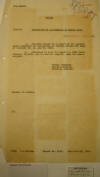
|
1.
February 18, 1930.
Secret G-2 Report on Activities
of C. A. Sandino in Mexico City
on February 13, 14, and 15,
1930, Gordon Johnson, Military
Attaché.
"1. Attached hereto is a report
of the special agent regarding
the activities of Sandino during
the days of 13, 14, and 15,
1930. ¶ 2. Reference
is made to report No. 2759 dated
February 13, 1930, and to
earlier reports, upon the same
subject."
|
|
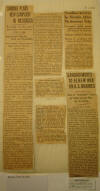
|
2.
February 1930. Press
clippings: Feb 16: "Mexico Holds Sandino's Aid,"
A.P. Feb 18:
"Sandino Plans New Campaign In
Nicaragua,"
N.Y. Evening
Post.
Feb 19: "Sandino Aid Missing,"
U.P. Feb 26: "Sandino Arrives in Merida
After Mysterious Trip,"
New
York Herald Tribune. Feb 28: "Sandino Moves to
Renew War On U.S. Marines,"
Chicago Daily News.
"SANDINO PLANS NEW
CAMPAIGN IN NICARAGUA ¶ “No
Gringo Can Stop Him,” Exiled
Rebel Leader Declares in Mexico
City ¶ HOLDS NIGHT PARLEYS WITH
HIS FOLLOWERS ¶ Few, However,
Regard Him as Able to Muster
Force for New Trouble ¶
Evening Post Foreign Service ¶
Copyright, 1930, by N. Y.
Evening Post, Inc. ¶ MEXICO
CITY, Feb. 17.—Augusto Sandino,
notorious Nicaraguan rebel and
now a “mystery man,” who has
been in Mexico City since
January 28, will go back to
Nicaragua for another campaign
and no “gringo” is going to stop
him, according to his own words.
¶ Sandino, who has been
“interned” at Merida, capital of
Yucatan, in tropical Mexico, for
some time, has been making his
Mexico City headquarters during
his stay here at the home and
office of Dr. Pedro J. Zepeda, a
University of Pennsylvania
graduate who is the rebel’s
“representative” in the Mexican
capital. ¶ What is Sandino’s
mission in Mexico City? How much
of a following has he? Will he
go back to Nicaragua? What is
his source of income? These are
questions asked by many. ¶ The
innocent-looking little Central
American guerrilla leader is so
much enshrouded in mystery and
has such dramatic appeal that
many Mexican students have
become Sandino sympathizers. ¶
But many persons who have
watched matters closely during
Sandino’s stay in Mexico City
believe that the famous rebel is
a “dead issue” as far as
starting more trouble in
Nicaragua is concerned. A bare
handful of followers met him at
the station here when he
arrived, and there has been
nothing to indicate that he has
a large following. ¶ Surrender
for Cash Denied ¶ Sandino
himself denied that he was
“bought off” for $60,000 and
said that “nothing can buy the
liberty of the Nicaraguan
people.” But there are few who
will believe that, and it is
certainly a fact that the rebel
leader is living comfortably at
Merida. ¶ The time is not yet
quite ripe for a return to
Nicaragua, “because Wall Street
still has its thumb on the
country, but I shall return
before long and the people will
gather about my banner,” Sandino
told the newspaper men in Mexico
City. ¶ Not much significance is
attached to the fact that
Sandino was received by
President Portes Gil at the
National Palace, in view of the
fact that this occurred just two
days before Portes Gil
relinquished his office to Ortiz
Rubio. Although the act of
giving an audience to an
anti-American rebel like Sandino
by the President of Mexico
ordinarily would be regarded as
unusual, it is believed that
Portes Gil realized that what
his outgoing administration did
carried little weight and that
he assumed a “what of it”
attitude. ¶ Aviation Colonel
Friendly ¶ Among the persons who
showed themselves sympathetic
toward Sandino was Colonel
Gustavo Leon, prominent Mexican
military flyer, who named a
plane after the rebel and also
took him up in his plane on one
occasion. ¶ That Sandino is a
“dead issue” is the prevailing
opinion in many unbiased and
well-informed circles, but that
something is brewing is an
undeniable fact. It is regarded
as significant that among the
Mexican officials who have
visited the rebel here in Mexico
City was the Governor of the
isolated territory of Quintana
Roo, a jungle region in
southeastern Mexico. During his
stay in Mexico City Sandino has
been rising late every morning
and it is a known fact that
“pow-wows” with some of his
followers last until the early
hours. ¶ The most logical theory
as to Sandino’s Mexico City
visit appears to be that he came
here in the hope of finding
encouragement for another
movement in Nicaragua. And it
also appears logical to assume,
judging from outside
appearances, that he did not
find sufficient encouragement. ¶
A performance was given recently
in honor of Sandino at a local
theatre, Sandino witnessing the
show from a box. The show had
some “anti-gringo” features. The
audience cheered wildly during
the performance. ¶
Mexico Holds Sandino’s Aid
¶ MEXICO CITY, Feb 15
(AP).—Auctin F. Marti
[Agustín Farabundo Martí],
secretary to Augustino Sandino,
former Nicaraguan rebel leader,
today was reported to have been
under detention for the last
twenty-four hours on a charge of
having uttered disparaging
remarks about President Pascual
Ortiz Rubio. He is a
Salvadorean. Sandino and his
staff have been here for a
fortnight, having come from
Merida. ¶ Sandino Aid
Missing ¶ MEXICO CITY,
Feb. 18 (UP).—“General” Agustino
Sandino, the Nicaraguan rebel
leader, is finding Mexico City
unhealthful for members of his
staff, and it has been learned
on reliable authority that the
“general” himself is beginning
to feel that a change of climate
might be advisable. It became
known today that the second of
Sandino’s aids has mysteriously
disappeared in the course of a
few days. The “general,” who
habitually is most careful to
avoid sitting near open windows
and incurring other unnecessary
risks, now is increasing his
precautions. ¶ Captain Jose
Parodes [José de Paredes], a member of the staff
who was sent on an errand by
Sandino last Sunday evening, has
not yet returned, which is
regarded as especially
disconcerting in view of the
fact that Esteban Pavletich,
another aide, similarly has been
“AWOL” since Thursday. ¶
Sandino Arrives In Merida After
Mysterious Trip ¶ Nicaraguan
Rebel Leader Appears in Mexican
Town; Left Capital on Saturday
¶ Chilean Cabinet to Resign ¶
Havana U. to Bestow Degrees on
Two Americans ¶ By Cable to the
Herald Tribune ¶ Copyright,
1930, New York Tribune Inc. ¶
MEXICO CITY, Feb. 25.—General
Augustino Sandino, rebel
Nicaraguan leader, was
officially reported to have
arrived at Merida at 4:50
o’clock this evening, following
his mysterious disappearance
from Mexico City on Saturday,
when he and a number of
followers left unexpectedly in
an automobile without making
their destination known. Mexico
City newspapers tonight carry
the news of his arrival at
Merida, commenting on the fact
that although he remained in the
Mexican capital about three
weeks, the rebel leader created
very little excitement by reason
of is [his?] exile and
mysterious movements. ¶
SANDINO MOVES TO RENEW WAR ON U.
S. MARINES ¶ End of “Armistice”
Seen as Rebel Leaves Mexico for
Home. ¶ BY JUNIUS B.
WOOD ¶ SPECIAL CABLE ¶ To the
Chicago Daily News Foreign
Service ¶ Copyright, 1930, The
Chicago Daily News, Inc. ¶
Mexico City, Feb. 27.—With the
“armistice” in Nicaragua drawing
to a close, the dawn of another
spasm of bloodshed and guerrilla
warfare in the little Central
American republic is due. “Gen.”
Augusto Sandino, firebrand
leader in the armed resistance
to American occupation, has left
Mexico City, and while not
returning directly to his
country, is prepared to resume
command of his forces and renew
fighting whenever occasion
requires. ¶ Possibly Washington
did not consider the last six
months’ lull in the fighting as
an armistice, but that is the
way it is viewed by leaders of
Nicaragua’s fight for
independence, as voiced here by
Dr. Pedro Jose Zepeda, who is
the guiding force behind the
movement. ¶ “Sandino left
Nicaragua voluntarily and we
gave orders to stop fighting six
months ago,” he said to The
Daily News correspondent today.
“Washington had said that as
soon as the country was pacified
the marines would be withdrawn.
We took the American state
department at its word and have
given it six months in which it
was able to withdraw without
loss of prestige and claim that
the country was pacified.
Apparently the United States
does not intend to keep its
promise, and the only thing to
do to win freedom and
independence for our country is
to [illegible]."
|
|
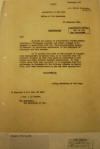
|
3.
February 12, 1930.
Confidential Report on Confidential Correspondence
Relating to Nicaraguan Aviators
& Anti-Imperialist League of
America, Acting Secretary of the
Navy.
""Nicaragua
#21 ¶ (COPY) ¶ A.G. 000.24
Nicaragua (2-12-30) ¶ DEPARTMENT
OF THE NAVY ¶ Office of the
Secretary. ¶ 12 February 1930. ¶
Confidential ¶ Secretary’s
Office, ¶ Feb 15 1930 ¶ War
Department ¶ Sir: ¶ Enclosed are
copies of confidential
correspondence relating to
Nicaraguan aviators and others
alleged to be engaged in
association with the
“Anti-Imperialistic League of
America” in activities
detrimental to the interests of
Nicaragua and this country. ¶ As
it appears that some of the
persons so engaged have
headquarters in Mexico City, it
is believed that the Military
Attache’ in that city would be
interested in the matter and
might furnish valuable
information. If such action
meets with your approval, it is
requested that the enclosures be
forwarded to the Military
Attache in Mexico City, with
such instructions as you may
deem appropriate. ¶
Respectfully, ¶ Acting Secretary
of the Navy. ¶ 15 Received
A.G.O. Feb. 20 1930 ¶ 1 Inc. –
10 sheets. ¶ The Honorable, ¶
The Secretary of War."
|
|
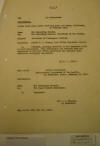
|
4.
February 11, 1930. G-2
Report on Activities of
Nicaraguan Aviators, Commanding General, Marine Corps
Base, Naval Operating Base, San
Diego, California, to Commanding
General, Department of the
Pacific.
"C_O_P_Y ¶ bdg ¶ 1st
Indorsement ¶ CONFIDENTIAL ¶
Marine Corps Base, Naval
Operating Base, San Diego,
California, ¶ 11 February 1930.
¶ From: The Commanding General.
¶ To: The Commanding General,
Department of the Pacific. ¶
Subject: Activities of
Nicaraguan aviators. ¶
Enclosure: Letter E. W. Bowman,
Post Office Inspector, 2-8-30. ¶
1. Returned, inviting attention
to the enclosure which is self
explanatory. This information
was obtained from the inspectors
of the Post Office Department
who consider their informants
thoroughly dependable. ¶ /s/ R.
H. DUNLAP. ¶ 494-1.04-30 ¶
SECOND ENDORSEMENT ¶
Headquarters, Department of the
Pacific, ¶ San Francisco,
Calif., February 13, 1930. ¶
CONFIDENTIAL ¶ From: The
Commanding General. ¶ To: The
Major General Commandant. ¶ 1.
Forwarded. ¶ /s/ F. D. Kilgore,
¶ By direction. ¶ Copy to CG,
MCB, NOB, SD, Calif."
|
|
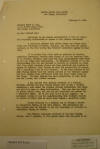
|
5.
February 8, 1930.
Letter from E. A. Bowman, United States Post
Office, San Diego, CA, to
Colonel Harry R. Lay, San Diego
CA, p. 1.
"UNITED STATES POST OFFICE ¶ San
Diego, California ¶ February 8,
1930. ¶ Colonel Harry R. Lay, ¶
U. S. Marine Corps Base, ¶ San
Diego, California ¶ My dear
Colonel Lay: ¶ Referring to our
recent conversation, I have to
submit the following information
in regard to the persons
mentioned: ¶ I have been advised
that Efrain Trava and Alonza
Garibaldi are residents of
Merida, Yucatan, and that they
are junior partners in the firm
having the Chrysler Automobile
Agency in that city. ¶ It is
stated they first took up
aviation in Yucatan, receiving
occasional lessons from flyers
of the Pan American Line. It is
claimed, however, that they had
only approximately four hours in
the air under such instruction.
My informant advises it is his
understanding that the men
desired to qualify as aviators
in order that they might
purchase planes and then
establish and operate an agency
in Yucatan; also, having in mind
the possibility of operating a
commercial line in that country.
It has been assumed at the Ryan
Flying School that the Senior
partner in the Chrysler Agency
has been sending them sufficient
funds for their needs while in
San Diego. The Ryan Company has
been endeavoring to sell these
men two planes, but without
success. ¶ I was advised that
Gonzalo Grabbell is a Chilian
[Chilean]. Grabbell advised the
Ryan Flying School that he has a
brother occupying a post under
the present Chilian [Chilean]
Government, but would not give
his name or other information.
This man had one month of ground
school work, but has not yet
completed his course for a
transport flyer. He is now said
to be in Los Angeles. My
informant stated it was his
understanding that Grabbell
desires to return to Chili
[Chile] when he shall have
become a qualified pilot. ¶
Carlos Polencia is a Mexican and
is taking a course in commercial
flying at the Ryan School. The
impression has been gained that
he intends to use his knowledge
of aviation in commercial flying
in Mexico. ¶ One Enrique
Castenada enrolled at the Ryan
Flying School, and, I presume,
is the person whose name you
gave me as . . . "
|
|
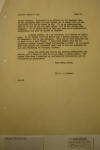
|
6.
February 8, 1930.
Letter from E. A. Bowman, United States Post
Office, San Diego, CA, to
Colonel Harry R. Lay, San Diego
CA, p. 2.
"Colonel Harry R. Lay. ¶ […]
Enrico Castino. Castenada is an
officer in the Mexican Army. He
was dismissed from the Ryan
School as it seemed that it was
impossible for him to learn to
fly. It is my understanding that
he is now at the Air Tech
School, but is not making much
progress. It is stated that he
does not seem to be particularly
intelligent and that he speaks
no English. ¶ Latonio Batres, so
I am informed, is a native of
Guatemala. It is stated that his
father was a former Minister of
War of Guatemala, but is now
deceased. This man is well
educated and is said to be a
fair flyer. I have been unable
thus far to ascertain Batres’
avowed object in becoming a
pilot. It is stated that both
Batres and Castenada have been
been or are now employed by one
Jack Thornburg at Phoenix,
Arizona. ¶ While the above may
not be the precise information
you desire, yet I trust it will
be of at least a little value.
The person from whom I received
my confidential information may
be considered as dependable. ¶
Very truly yours, ¶ /s/ E. A.
Bowman. ¶ EAB:JS"
|
|
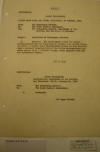
|
7. Jan. 29-30,
1930. 2nd & 3rd
Endorsements,
Report on Activities of
Nicaraguan Aviators,
San Diego, CA.
"C_O_P_Y_ ¶ CONFIDENTIAL ¶
SECOND INDORSEMENT ¶ MARINE
CORPS BASE, SAN DIEGO,
CALIFORNIA, 29 JANUARY, 1930. ¶
From: The Commanding Officer. ¶
To: The Major General
Commandant. ¶ VIA: The
Commanding General, Department
of the Pacific, San Francisco,
California. ¶ Subject:
Activities of Nicaraguan
Aviators. ¶ 1. Returned. The
undersigned turned the within
correspondence over to Major
Ross E. Rowell, U.S. Marine
Corps, in charge of Marine Corps
Expeditionary Forces at this
base, who made a personal
investigation of the within
correspondence and whose report
to me I transmit to you, which
complies with the 1st
endorsement hereon. ¶ /s/ H.
Lay. ¶ CONFIDENTIAL ¶ THIRD
ENDORSEMENT ¶ Headquarters,
Department of the Pacific, ¶ San
Francisco, Calif., January 30,
1930. ¶ From: The Commanding
General. ¶ To: The Major General
Commandant. ¶ 1. Forwarded. ¶
/s/ Logan Feland."
|
|
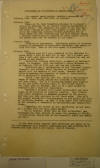
|
8.
February 15, 1930. Secret
G-2 Report on Activities of C.
A. Sandino in Mexico City, February 13th, 14th, and 15th,
1930.
"Activities
of C.A. Sandino in Mexico City.
¶ The special agent reports
Sandino’s movements on February
13th, 14th, and 15th, 1930, as
follows: ¶ February 13th: ¶
“Arose at 11, took breakfast,
returned to Dr. Zepeda’s office
on Balderas St. to receive
visitors, increasing in number
daily. His afternoon was spent
in the same way, and when I
called at 6:30 I was unable to
talk with him as he was
receiving intimate friends,
including two or three women who
were entertaining him with
Mexican songs. I learned,
however, that he expects to
leave Mexico City at any moment,
with all the members of his
staff.” ¶ February 14th: ¶
“Nothing of importance.
Increasing number of visitors.
Sandino is preparing to leave;
date uncertain; was unable to
talk with him. Most of his time
spent in diversion.” ¶ February
15th: ¶ “Sandino rose at 1 p.m.,
remained in the Balderas St.
house until 3 when he went out
to eat. At 8 o’clock p.m., when
I left said house, he had not
yet returned, but was expected
at any moment. ¶ “Pavletich
(Esteban Pavletich), a member of
Sandino’s staff, is missing;
left Gen. Sandino’s house,
Balderas 24, on February 13th at
2:30 p.m. and has not returned.
¶ “Pavletich was a collaborator
of the ‘Nacional Revolucionario’
and Colonel Martí (another of
Sandino’s staff) talked with the
manager of that paper, Senator
Manlio Fabio Altamirano, who
promised to order an
investigation as to Pavletich’s
whereabouts. ¶ “While I was
talking with Col. Martí a
well-dressed woman of about
thirty, called and inquired if
Pavletich had been found. She is
a Nicaraguan, speaks good
English as she has lived
fourteen years in the United
States. Her first name is
Soledad, said to be a good
friend of Sandino’s, but I find
her suspicious. ¶ “Sandino’s
friends have become distrustful
and have taken on an attitude of
absolute reserve. They believe
that their telephone is censored
by the police, and they are very
cautious in all their acts. They
will not report Pavletich’s
disappearance to the police, for
fear of involving Sandino, as
some of them admit that
Pavletich, if not actually a
communist in affiliation, has
communistic ideas. ¶ “Regarding
the arrest of Col. Martí, this
is not true, as I talked with
him last night myself. ¶ “As to
Sandino, Martí told me that he
(Sandino) was arranging the last
details to begin his journey to
Mérida, Yucatán, where twenty
men of the General’s staff are
awaiting him.” ¶ It has been
since learned that Pavletich got
mixed up in the infringement of
a traffic regulation, and was
arrested as a witness, but held
only a few hours. Now at
liberty."
|
|
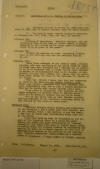
|
9.
February 13, 1930.
Secret G-2 Report on Activities of C.
A. Sandino in Mexico City on
February 8th, 9th, 10th, 11th,
and 12th, Gordon Johnson,
Military Attaché, p. 1.
"G-2 Report ¶ MEXICO ¶ SUBJECT:
Activities of C. A. Sandino in
Mexico City. ¶ 1. Reference is
made to Report No. 2755 dated
February 11, 1930, and to
earlier reports, upon the above
subject. ¶ 2. The special agent
reports Sandino’s movements on
February 8th, 9th, 10th, 11th,
and 12th, as follows: ¶ February
8th: ¶ “Nothing of importance.
Received visitors, and was
invited to dine at the home of
Isidro Fabela, a lawyer.
Tomorrow he will attend as the
honor guest a bullfight which is
to be given by the press.” ¶
February 9th: ¶ During the
morning as usual, receiving
friends. Went to the bullfight,
and had not returned home at 10
p.m.” ¶ February 10th: ¶ “Made
three attempts to see Sandino
today, without success, and upon
inquiring of his aides where he
might be found, they were
reticent and I decided not to
insist. It is to be presumed
that on these visits which
Sandino is making he is
accompanied only by Dr. Zepeda,
as Gen. Estrada, as also Col.
Rivera, Col. Marti, and Sr.
Pavletich, could always be found
at the Balderas St. office of
Dr. Zepeda. ¶ “From Col. Rivera
I learn that they are expecting
to leave at any time, but not
before February 15th. Since upon
several occasions they have
stressed this date, undoubtedly
they are to hold a secret
meeting on that day to decide
what course Sandino shall take.
¶ “I am given to understand that
tomorrow we will begin studying
the private files of Sandino,
which I could not do today, as
Sandino was not to be found. ¶
“One of his aides told me that
Sandino received several
ovations at the bullfight
yesterday, where he was invited
by the Press, as honor guest. ¶
February 11th. ¶ “Received
friends during morning, and
afternoon. In the forenoon I had
a brief chat with Sandino; and
in the evening while I was
waiting to see him again, I was
able to learn some interesting
facts from one of his aides. ¶
“This aide told me that in
Nicaragua, in the region of the
Segovias, there is a young man,
about twenty-two years old,
known thereabouts as ‘General
Ferrerita’, but whose real name
is Miguel Angel Ortez, he having
taken the surname Ferrera to
intimidate his enemies, as there
is a famous general of this name
in Honduras, much feared by the
natives of his country. This
‘General Ferrerita’ holds,
hidden, in a certain place in
Nicaragua, a large number of
rifles, machine . . .
¶ From: M.A.Mexico. ¶ Report No.
2759. ¶ Date: Feb. 13, 1930."
This document translated
via the kind courtesy of Walter
C. Sandino. // Este
documento traducido a través la
amable cortesía de Walter C.
Sandino. "Reporte
del G-2 ¶ Méjico
¶ Asunto: ¶
Actividades de C. A. Sandino en
la Ciudad de Méjico ¶
1. Se hace referencia al reporte
No 2755 fechado febrero 11,
1930, y a reportes anteriores,
sobre el asunto antes
mencionado. ¶ 2. El
agente especial reporta los
movimientos de Sandino 8, 9, 10,
11 y 12 de febrero, de la forma
siguiente: ¶ Febrero 8:
¶ "nada de importancia.
Recibió visitas y fue invitado a
cenar en la casa de Isidro
Favela, un abogado. Mañana él
(Sandino) va como invitado de
honor a una corrida de toros la
cual será dada por la prensa."
¶ Febrero 9: ¶
"Pasando la mañana de forma
usual, recibiendo amigos.
Fue a la corrida de toros, y no
había regresado a casa a las
10pm." ¶ Febrero 10:
¶ "Hice tres intentos para
ver a Sandino hoy, sin éxito, y
al preguntarles a sus asistentes
donde podría estar él, ellos se
portaron reticentes y yo decidí
no insistir. Se presume
que en estas visitas que Sandino
está haciendo, él está haciendo
acompañado solamente por el
Doctor Zepeda, ya que General
Estrada, también el Coronel
Rivera, el Coronel Martí, y el
Sr. Pavletich, siempre se
podrían encontrar en la oficina
de Calle Balderas del Doctor
Zepeda. ¶ "De parte
de Coronel Rivera, yo supe que
ellos esperan partir en
cualquier momento, pero no antes
de febrero 15. Puesto que
en varias ocasiones ellos han
insistido en esta fecha; sin
lugar a dudas, ellos van a tener
reuniones secretas en esas
fechas para decidir qué curso
Sandino deberá tomar. ¶
"Se me ha dado entender que
mañana comenzaremos a estudiar
los archivos privados de
Sandino, lo cual no pude hacer
hoy, ya que Sandino no se pudo
hallar. ¶ "Uno de
sus ayudantes me dijo que
Sandino recibió varias ovaciones
en la corrida de toros de ayer,
donde él fue invitado por la
prensa, como invitado de honor.
¶ Febrero 11: ¶
"Recibió amigos durante la
mañana y la tarde. Al
medio día yo tuve una charla
breve con Sandino; y en la noche
mientras yo estaba esperando
verlo de nuevo, pude darme
cuenta de algunos datos
interesantes de parte de unos de
sus asistentes. ¶
"Este asistente me dijo que en
Nicaragua, en la región de las
Segovias, hay un hombre joven de
unos 22 años, conocido ahí como
"General Ferrerita", pero que su
verdadero nombre es Miguel Ángel
Ortéz. Quien había tomado
el sobre el sobrenombre
"Ferrera" para intimidar a sus
enemigos, ya que hay un famoso
general de este nombre en
Honduras, muy temido por los
nativos de su país. Este
"General Ferrerita" tiene
escondido, en cierto lugar en
Nicaragua, un gran número de
rifles, ametralladoras ... "
|
|
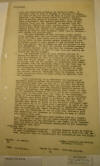
|
10. February 13, 1930.
Secret G-2 Report on Activities of C.
A. Sandino in Mexico City on
February 8th, 9th, 10th, 11th,
and 12th, Gordon Johnson,
Military Attaché, p. 2.
"G-2 Report ¶ " . . . guns and
ammunition, belonging to
Sandino’s army. My informant
told me that he started an
uprising in Nicaragua with 25
men, and now has an army of
2,000 men, perfectly armed, who
are under direct orders of
General Sandino. That in another
place in Nicaragua there is a
‘General Pedro Altamirano’ with
another goodsized group of men.
Likewise there are two
‘Colonels’ in action,- all
acknowledging Sandino as their
supreme chief. That the machine
guns which Ferrerita has hidden,
and which he is himself using,
are ‘Lewis’ and ‘Thompson’. My
informant assured me that in
this equipment there were no
cannons,- only rifles and
machine-guns. ¶ “He also
informed me that the last formal
combat which Sandino held with
the North American marines was
on April 27, 1929, upon which
date he decided to come to
Mexico to clear up many obscure
points regarding his true
situation, since in some places
it was believed that he had been
killed, and in others he was the
subject of endless calumnies. He
made his journey to Mexico,
crossing all Central America
until reaching the Mexican
frontier in Guatemala, whence he
came to Vera Cruz and finally
embarked for Mérida, Yucatán. ¶
“My informant tells me that
Sandino now has in Mexico 25
members of his staff and that in
order to return to Nicaragua it
will be necessary to collect not
less than 10,000 pesos. Upon
asking him if Sandino came to
Mexico City for the purpose of
collecting said funds, he
replied that the principal
object of his visit was to
organize some isolated groups
which morally supported the
Nicaraguan movement, and that he
intended to carry on this work
on his return journey to
Nicaragua, in all the Central
American countries which he
crosses, as in those countries
there are also groups in
sympathy with his movement. ¶
“Upon explaining to my informant
the impotence of Sandino’s army
to defeat the American marines,
he replied that Sandino knew
that as well as I, but that his
object was not precisely to
openly face the American marines
in combat, but to cause them the
greatest possible amount of
damage, by burning, and sacking
their mines, as well as all
property belonging to North
American citizens; that they
would do the same with the works
of the Nicaraguan Canal if its
building was begun,- that is,
while thousands of dollars were
being spent to construct only
one part of the Canal, a little
dynamite would destroy it all.
That Sandino only wants to prove
to the American Government that
it can never do as it likes with
Nicaragua, in spite of its
wealth and power, as with this
system of opposition it will
soon be convinced, and leave
Nicaragua in absolute liberty.
From all the foregoing it can be
seen that Sandino’s plan for
combatting the invasion of
Nicaragua is easy to carry out,
without much cost. ¶ My
informant confirms what Sandino
told me,- namely, that in order
to carry out his plans, Sandino
needs neither the cooperation of
any Government, nor funds, as he
reckoned upon the will of the
Nicaraguan people, who on all
occasions cooperated with him.”
¶ February 12th: ¶ “Nothing of
importance, except a private
banquet given to Sandino by some
Nicaraguan students. Was not
able to talk with the General
today, but have an appointment
for tomorrow, to see his files.”
¶ Gordon Johnston, Col. Cavalry
¶ Military Attaché. ¶ Source: As
stated. ¶ J/p ¶ From:
M.A.Mexico. ¶ Report No. 2759. ¶
Date: Feb. 13, 1930."
This document translated
via the kind courtesy of Walter
C. Sandino. // Este
documento traducido a través la
amable cortesía de Walter C.
Sandino.
" ... y
municiones, pertenecientes al
Ejército de Sandino. Mi
informante me dijo que él inició
un levantamiento en Nicaragua
con 25 hombres, y que ahora
tiene un ejército de dos mil
hombres, perfecta mente armados,
quienes están bajo las órdenes
directas del General Sandino.
Que en otro lugar en Nicaragua
hay un "General Pedro
Altamirano" con otro grupo de
hombres de buen tamaño. De
igual manera hay dos coroneles
en acción. – todos
reconociendo a Sandino como su
Jefe Supremo. Que las
ametralladoras que tienen
escondidas Ferrerita, y las
cuales él mismo está usando, son
"Lewis" y "Thompson". Mi
informante me aseguro que en
este equipo no hay cañones.
Solamente rifles y
ametralladoras. ¶ El
también me informo que el último
combate real que Sandino tuvo
contra los marinos
norteamericanos fue el 27 de
abril de 1929, fecha en la cual
él decidió viajar a Méjico para
aclarar muchos puntos oscuros
respecto a su verdadera
situación, puesto que en algunos
lugares se creía que a él lo
habían matado; y en otros él era
el tema principal de grandes
calumnias, él hiso su viaje a
Méjico, cruzando toda Centro
América hasta llegar a la
frontera Mejicana en Guatemala,
donde llego a Veracruz y
finalmente se embarcó para
Mérida, Yucatán. ¶
Mi informante me dice que
Sandino ahora tiene en Méjico 25
miembros de su personal y que
para poder regresar a Nicaragua
será necesario colectar no menor
de 10,000 pesos. Al
preguntarle a él, si Sandino
vino a Méjico con el objetivo de
colectar tales fondos, él me
contesto, que el principal
objetivo de su visita era para
organizar algunos grupos
aislados, quienes moralmente
apoyaban al movimiento en
Nicaragua, y que él incluso
intentaría llevar a cabo este
trabajo en su viaje de regreso a
Nicaragua, en tránsito por todos
los países de Centro América, ya
que en esos países también hay
grupos que simpatizan con su
movimiento. ¶ Al
explicarle a mi informante la
importancia del Ejercito de
Sandino para derrotar a los
marines norteamericanos, él
contesto que Sandino sabia eso
también como yo, pero que su
objetivo no era precisamente
enfrentar abiertamente a los
marines norteamericanos en
combate, sino causarles el más
grande daño posible, por medio
de quemar y saquear sus minas,
así como toda propiedad que
perteneciese a ciudadanos
norteamericanos; que ellos
harían lo mismo con las obras
del Canal nicaragüense si se
comenzaba la construcción.
Es decir, mientras de miles de
dólares se están gastando para
construir solo una parte del
Canal, un poquito de dinamita lo
destruiría todo. Que
Sandino solamente quiere
probarle al Gobierno
norteamericano que jamás puede
hacer como quiera con Nicaragua,
a pesar de su esfuerzo y su
poder, así como se convencerá
con este sistema de oposición
muy pronto, y dejara a Nicaragua
en libertad absoluta. Con
todo lo que está sucediendo se
puede ver que el plan de Sandino
para combatir la invasión de
Nicaragua es fácil llevar a
cabo, sin mucho costo. ¶
Mi informante confirma lo que
Sandino me dijo;
--principalmente de que para
llevar a cabo sus planes,
Sandino no necesita la
cooperación de ningún gobierno,
ni fondos, ya que él confía en
la voluntad del pueblo
nicaragüense, quienes en todas
las ocasiones han cooperado con
el." ¶ Febrero 12:
¶ Nada de importancia, a
excepción de un banquete privado
dado a Sandino por unos
estudiantes nicaragüenses.
No pude hablar con el General
hoy, pero tengo una cita mañana,
para ver sus documentos. ¶
Fuente: Como declaración ¶
Gordon Johnston, Coronel de
Caballería ¶
Agregado militar ¶ Desde:
M. A. México. Reporte No.
2759. Fecha: Feb.13,
1930."
[NOTE: The next
special agent report for Feb.
13-14 can be found on
TOP
100, PAGE 95, PAGE 3, DOCS 48 &
49. //
NOTA: El próximo informe
del agente especial de 13 a 14
febrero se encuentra en el
TOP
100, PÁG. 95, PÁG. 3, DOCS 48 &
49]
|
|
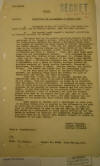
|
11. February 13, 1930.
Secret G-2 Report on Activities of C.
A. Sandino in Mexico City on
February 7th, Gordon Johnson,
Military Attaché.
"G-2 Report ¶ MEXICO ¶ SUBJECT:
Activities of C.A. Sandino in
Mexico City. ¶ 1. Reference is
made to Report No. 2743 dated
February 6, 1930, and to earlier
reports, upon the above subject.
¶ 2. The special agent report’s
Sandino’s activities on February
7th, 1930, as follows: ¶ “He
spent most of the morning
receiving friends and
sympathizers in Dr. Zepeda’s
office. After 12 o’clock he went
to the Independence Monument and
placed a porcelain wreath near
the remains of Hidalgo and other
heroes of Mexican independence,
the wreath bearing a card: ‘With
all our respect and admiration
to the invincible Hidalgo and
other heroes of the Mexican
Independence. Mexico February 7,
1930. Patria y Libertad. A.C.
Sandino and Pedro J. Zepeda.’
There were some local newspaper
men and photographers present.
Also accompanying Gen. Sandino
were Col. Enrique Rivera
Bertrand, Sr. Esteban Pavletich,
and Dr. Zepeda, all members of
his staff; also Rodolfo Artiga
López, a Salvadorean newspaper
men, and Ernesto Carrera a
Guatemalan; also a group of
Central American university
students composed of – Marco
Aurelio Chavarría, Francisco J.
Mazariegos, Alejandro Ch. López,
Delfino Escobar, and Joaquín
Rivera. The wreath was draped
with the Nicaraguan flag. ¶ “As
the days pass, the number of
Sandino’s visitors increases,
the majority being young men
between the ages of twenty-five
and thirty, his loyal followers.
¶ “From what I have been able to
observe, Sandino has undoubtedly
come to carry on an active
propogadna [propaganda] in favor
of his cause. From his
appearance, he seems to be
satisfied with the result of his
activities. He promised me again
today that he would give me, for
publication, something of vital
importance to the peoples of
Spanish America and for the
entire world. He has also
offered me his private files,
that I may publish whatever I
find of interest; and from the
cursory glance over some of the
papers two days ago, some of
those documents are certainly of
value, not only because they are
unknown to the public, but also
because they explain many
things. ¶ “Upon saying to
Sandino that I understood he
would soon be leaving Mexico
City he replied in the
affirmative, but said he would
not go before the 15th of this
month. He plans to stay in
Mérida, where he says he has men
waiting for him, and showed me a
photograph in which appear
several of his comrades, in
uniform and carrying the
Nicaraguan flag; also armed.
This all leads me to believe
that Sandino intends to return
to Nicaragua in the near
future.” ¶ Gordon Johnston, ¶
Colonel, Cavalry, ¶ Military
Attaché. ¶ Source: Confidential.
¶ J/p ¶ From: M.A.Mexico. ¶
Report No. 2755. ¶ Date: Feb.
11, 1930."
This document translated
via the kind courtesy of Walter
C. Sandino. // Este
documento traducido a través la
amable cortesía de Walter C.
Sandino.
"Reporte G-2 ¶
Mejico ¶ Asunto:
Actividades de C. A. Sandino en
la Ciudad de Méjico ¶
1. Se hace referencia al reporte
numero 2743 fechado el 6 de
febrero de 1930, y a reportes
anteriores, acerca del asunto
antes mencionado. ¶
2. El agente especial reporta
las actividades de Sandino el 7
de febrero de 1930, de la forma
siguiente: ¶ "El
pasó la mayor parte de la mañana
recibiendo amigos y
simpatizantes en la oficina del
Dr. Zepeda. Después de las
12 m. en punto, el fue al
Monumento de la Independencia y
puso una guirnalda de porcelana,
cerca de los restos de Hidalgo y
otros héroes de la independencia
de Méjico. La guirnalda
llevaba una tarjeta:
"con todo el respeto y
admiración al invencible hidalgo
y otros héroes de la
independencia de Méjico. Patria
y libertad". Habían algunos
periodistas locales y fotógrafos
presentes. También acompañando
al General Sandino estaban el
Coronel Enrique Rivera Bertrand,
el Sr. Esteban Pavletich, y el
Dr. Zepeda, todos los miembros
de su personal; también Rodolfo
Artiga López, periodista
salvadoreño, y Ernesto Carrera,
guatemalteco; también un grupo
de estudiantes universitarios de
Centro América, compuesto por –
Marco Aurelio Chavarría,
Francisco J. Mazariegos,
Alejandro Ch. López, Delfino
Escobar, y Joaquín Rivera.
La guirnalda fue adornada con la
bandera nicaragüense. ¶
A medida que pasaban los días el
número de los visitantes de
Sandino aumenta, la mayoría son
hombres jóvenes, entre las
edades de 25 a 30 años, sus
fieles seguidores. ¶
"De lo que yo he podido
observar, Sandino sin lugar a
dudas ha venido llevando a cabo
una propaganda activa a favor de
su causa. Por su
apariencia, él parece estar
satisfecho con los resultados de
sus actitudes. El me
prometió otra vez hoy que el me
daría para su publicación, algo
de vital importancia para el
pueblo de la América Hispana y
para el mundo entero. El
también me ha ofrecido sus
archivos privados, que yo podría
publicar aquello que considere
de interés; y de la observación
rápida de algunos de los papeles
de hace dos días, alguno de
estos documentos son ciertamente
de valor, no solamente porque
estos son desconocidos al
público, sino también por que
explican muchas cosas. ¶
"al decirle a Sandino que yo
tenía entendido que él pronto
estaría abandonando la Ciudad de
Méjico, él contesto de forma
afirmativa, pero dijo que él no
se iría antes del 15 de este
mes. El planea quedarse en
Mérida, donde dice que tiene
hombres esperándolo, y me mostró
más fotografías en la cual
aparecen varios de sus
camaradas, en uniforme y
cargando la bandera
nicaragüense, y también armados.
Todo esto nos lleva a creer que
Sandino tiene intenciones de
regresar a Nicaragua en su
futuro cercano." ¶ Fuente:
confidencial. Gordon
Johnston, Coronel de Caballería
¶ Agregado militar ¶
Desde: M. A. México.
Reporte No. 2755. Fecha:
Feb.11.1930."
|
|
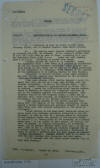
|
12.
February 6, 1930. Secret
G-2 Report on Activities of C.
A. Sandino in Mexico City on
February 4, Col. Gordon
Johnston, Military Attaché, p.
1.
"G-2
Report ¶ MEXICO ¶ SUBJECT:
Activities of C. A. Sandino in
Mexico City. ¶ 1. Reference is
made to Report No. 2736 dated
February 3, 1930, and to earlier
reports, upon above subject. ¶
2. The special agent reports
Sandino’s activities on February
4th, 1930, as follows: In Dr.
Zepeda’s office from 11 a.m. to
2 p.m. when he went to lunch,
returning at 3 p.m. and
remaining there until 8 p.m.
Agent was with Sandino from 4 to
8 p.m. Following is quoted from
Agent: ¶ “Sandino placed his
files at my disposal. Among the
documents which I read today is
a project of unification of all
the Spanish-American countries,
which project Sandino states he
will carry out as soon as he
takes possession of the
Government of Nicaragua, which
depends on the success of the
conferences he is holding
nightly in this Capital. ¶
“According to General Sandino,
every night sessions are held
between persons most interested
in the so-called
‘anti-imperialistic’ movement. ¶
“From some phrases which Sandino
dropped I could observe that
they are not on a very good
footing with the Mexican
Government. In one of the
letters which I read, sent by
Zepeda (Sandino’s representative
in Mexico City) to Sandino, I
noted the difficulties which
Sandino encountered in donating
to Mexico the ‘trophies’
obtained by him in the struggle
against the American marines.
Said trophies consist of two
surgical cases, a rifle and an
American flag, which objects, by
agreement of the Mexican
Government, are now in the
Mexican National Museum. ¶ “Upon
asking Sandino if the secret
sessions were being held with
members of the Mexican
Government, he appeared a little
suspicious, and confined himself
to saying that ‘they were with
persons interested in the cause
of Nicaragua’. ¶ “After showing
me air maps, small books, and
other objects taken from
American prisoners belonging to
the 5th Regiment, he told me
that in a certain place in
Nicaragua he was keeping hidden
the remains of the aviator
Thomas, of Captain E. A. Rector,
chief of the squadron, of a
doctor whose name I do not
recall at this moment, of
Captain William Williamson, of
Captain Livingstone, of
Lieutenant Bruce, and of another
aviator whose name also I do not
recall, also of Roy A. Johnston,
an American engineer who on a
certain occasion went to him to
propose a conference in order to
settle a conflict, with the sole
object of assassinating him
(Sandino). Sandino himself told
me he would return the said
remains when Nicaragua was free
again. ¶ “It is assumed that the
usual secret session will be
held this evening.” . . . ¶ From:
M.A.Mexico. ¶ Report No. 2743. ¶
Date: Feb. 6, 1930."
This
document translated via the kind
courtesy of Walter C. Sandino.
// Este documento
traducido a través la amable
cortesía de Walter C. Sandino.
"Reporte G-2
¶ Asunto:
Actividades de C. A. Sandino en
la Ciudad de Méjico ¶
1. Se hace referencia al reporte
No 2736 fechado febrero 4
,1930,y a reportes anteriores ,
sobre el asunto antes
mencionado. ¶ 2. El
agente especial reporta las
actividades de Sandino de
febrero 4, 1930, en la forma
siguiente: Estuvo en la
oficina del Dr. Zepeda, desde
las 11 am hasta las 2 pm, cuando
él fue almorzar, regresando a
las 3 pm y permaneciendo ahí
hasta las 6 pm. El agente
estaba con Sandino de las 4pm a
las 6 pm. Lo siguiente es tomado
de las propias palabras del
agente. ¶ "Sandino
puso sus archivos a mi
disposición. Entre los
documentos que yo leí hoy, esta
un Proyecto de unificación de
todos los países hispano
americanos, Proyecto en el cual
Sandino declara que llevará a
cabo tan pronto como él tome
posesión del Gobierno de
Nicaragua, el cual depende del
éxito de las conferencias que
está sosteniendo cada noche en
esta capital. ¶ De
acuerdo al General Sandino, se
celebran sesiones todas las
noches entre personas muy
interesadas en el tal llamado
movimiento "anti-imperialista".
¶ De algunas frases que
pronuncio Sandino yo pude
observar que ellos no están en
términos muy buenos con el
Gobierno Mejicano. En una
de las cartas que yo leí,
enviada por el Dr. Zepeda
(Representante de Sandino en la
Ciudad de Méjico) a Sandino, yo
note las dificultades a que se
enfrento Sandino al donar a
Méjico "los trofeos" obtenidos
por él en la lucha contra los
marines americanos. Los
mencionados trofeos consisten en
dos cajones para cirugía, un
rifle y una Bandera americana, y
tales objetos, por acuerdo del
Gobierno Mexicano, están ahora
en el Museo Nacional Mejicano.
¶ Al preguntarle a Sandino
si las secciones secretas
estaban siendo sostenidas con el
Gobierno Mejicano, el pareció
sospechar, y se limito a decir
que ellos estaban con personas
interesadas en la causa de
Nicaragua". ¶
Después de mostrarme mapas
aéreos, pequeños libros y otros
objetos tomados de los
prisioneros pertenecientes al
quinto regimentó, el me dijo que
en cierto lugar de Nicaragua, el
estaba manteniendo escondido los
restos del aviador Thomas, del
Capitán E. A. Rector, Jefe de
Escuadrón, de un Doctor cuyo
nombre no recuerdo en este
momento, del Capitán William
willianson, del Capitán
Livingstone, del Teniente Bruce,
y de otro aviador quien cuyo
nombre tampoco recuerdo, también
el de Roy A. Johnston, un
ingeniero americano quien en
cierta ocasión fue donde él para
proponerle una reunión para
poder arreglar un conflicto,
pero con el único fin de
asesinarlo a él (Sandino).
Sandino mismo me dijo que él
podía devolver los mencionados
restos cuando Nicaragua llegara
a ser libre otra vez. ¶
Se asume que la acostumbrada
sesión secreta se va a celebrar
esta noche." ¶
Desde: M. A. México.
Reporte No. 2743. Fecha:
Feb. 6, 1930."
|
|
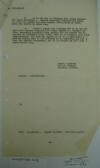
|
13.
February 6, 1930. Secret
G-2 Report on Activities of C.
A. Sandino in Mexico City on
February 4, Col. Gordon
Johnston, Military Attaché, p.
2.
"
. . . G-2 Report ¶ 3. As to the
day of February 5th, Agent
reports the usual procedure,-
Sandino receiving visitors and
going out with Dr. Zepeda for
some unknown destination to
which Agent was unable to trace
him. ¶ 4. Agent’s report for
February 6th is to the effect
that Sandino remained the entire
day in Dr. Zepeda’s office,
receiving visitors; that Sandino
did not attend the inaugural of
President Ortiz Rubio; that he
is becoming much less
communicative, and does not
appear to be in as optimistic a
mood as first; that it not
believed he is receiving any aid
from the Mexican Government, and
it is thought he will soon leave
Mexico City. ¶ Gordon Johnston ¶
Colonel, Cavalry ¶ Military
Attaché. ¶ Source: Confidential.
¶ J/p ¶ From: M.A.Mexico. ¶
Report No.2743. ¶ Date: Feb. 6,
1930."
This
document translated via the kind
courtesy of Walter C. Sandino.
// Este documento
traducido a través la amable
cortesía de Walter C. Sandino.
"Reporte G-2:
¶ 3. Según el día 5 de
febrero, el agente reporta el
procedimiento usual.
Sandino recibiendo visitantes y
saliendo con el Dr. Zepeda a un
destino desconocido, por lo que
el agente no puedo darle
seguimiento. ¶ 4. El
agente reporta para el 6 de
febrero, que Sandino permaneció
todo el día en la oficina de el
Dr. Zepeda recibiendo
visitantes; que Sandino no
asistió a la inauguración del
Presidente Ortiz Rubio; que él
se está volviendo menos
comunicativo y no parece estar
en un estado de ánimo optimista,
como lo estuvo al principio; que
no se cree que este recibiendo
ninguna ayuda de parte del
Gobierno Mejicano, y se cree que
pronto abandonara la Ciudad de
Mejico. ¶ Fuente:
confidencial. Gordon
Johnston, Coronel de Caballería.
Agregado militar ¶
Desde: M. A. México.
Reporte No. 2743. Fecha:
Feb. 6, 1930."
|
|
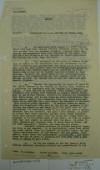
|
14.
February 3, 1930. G-2
Report on Activities of C. A.
Sandino in Mexico City, Col.
Gordon Johnston, Military
Attaché, p. 1.
"G-2
Report ¶ MEXICO ¶ SUBJECT:
Activities of C. A. Sandino in
Mexico City. ¶ 1. In connection
with report No. 2735 (Jan. 31,
1930), the fact that Sandino
visited President Portes Gil has
been guarded with the greatest
reserve. Neither local nor
foreign correspondents have been
informed of the fact. The
officials and servants at the
Castillo de Chapultepec, where
the meeting was held, deny the
visit. ¶ 2. With reference to
the visit to Mexico attention is
called to the despatches from
the Ambassador to the State
Department, and particularly one
dated Aug. 3, 1929 (No.1774).
From this the fact appears that
the Government only promised
absolutely that Sandino should
not be permitted to visit Mexico
City on his way to Yucatán upon
his arrival in this country.
However, the whole sense of the
conversation, and apparently the
understanding, was that Sandino
would not be allowed to visit
the Capital and utilize his
visit for propaganda purposes. ¶
3. Sandino was apparently the
guest of honor at the Lirico
Theatre on the evening of
January 31st, sitting in a
prominent box decorated with the
Mexican and Nicaraguan colors. A
skit was put on entitled “Viva
Sandino” which had evidently
been fairly well censored as
regards direct reference to the
United States. However, the
indications throughout were
quite clear, and in one scene an
actor representing Sandino
appears waving the Nicaraguan
flag over three dead soldiers
whose uniforms were just enough
to indicate U.S. Marines; this
received great applause. In
another scene an actor takes the
Nicaraguan flag over to the box
and presents it to Sandino, who
stands up and waves it, to the
great glee of the spectators. He
frequently rose to his feet and
gave a salute, somewhat like the
Faccisti, and made a few
remarks, in general effect that
Latin American nations would
stand together. There were
frequent calls from the house
for a song which is supposed to
be the battle-hymn of his army,-
to such an extent that they were
unable to proceed with the play.
An actor finally appeared and
promised that it would come in
later, and the show proceeded.
However, the song was not given.
¶ Numerous Mexican officers in
uniform occupied boxes, but this
is not unusual. It is
particularly noted that while
the crowd yelled “Bajo los
Yanquis” at various times, the
cry “Muere los Americanos, or
los Yanquis” was not given.
Altogether, while there was
considerable applause, etc., the
enthusiasm was not as great as
expected, not more than such a
skit would be likely to call
forth. ¶ 4. As for the events of
the day January 31st, Sandino
continued receiving friends and
sympathizers in the . . .
¶ From: M.A. Mexico. ¶ Report
No.2736. ¶ Date: Feb. 3, 1930."
This
document translated via the kind
courtesy of Walter C. Sandino.
// Este documento
traducido a través la amable
cortesía de Walter C. Sandino.
"Reporte G-2. ¶
Asunto: Actividades de C.
A. Sandino en la Ciudad de
Méjico ¶ 1. En
conexión con el reporte numero
2735 (enero 31. 1930), el hecho
de que Sandino visitó al
Presidente Portes Gil, ha sido
guardado con mucha reserva.
No se le informo ni a
corresponsales extranjeros, ni
locales, acerca del hecho.
Los oficiales y servicios en el
Castillo de Chapultepec, donde
se celebro la reunión, niegan la
visita. ¶ 2. Con
referencia a la visita a Méjico,
se hace notar acerca de los
despachos de parte del Embajador
(norteamericano) al Departamento
de Estado, y particularmente uno
fechado agosto, 3, 1929 (No.
1774). De este hecho se
desprende que el Gobierno
(Mejicano) solamente se
comprometió a que a Sandino no
se le permitiría visitar la
Ciudad de Méjico, en su paso
hacia Yucatán a su arribo a este
país. Sin embargo, en
todos los sentidos de la
conversación, y aparentemente se
entendía que a Sandino no se le
permitiría visitar la Capital y
utilizar su visita con fines de
propaganda. ¶ 3.
Sandino era aparentemente el
invitado de honor en el Teatro
Lírico en la noche del 31 de
enero, con un Balcón de honor y
decorado con los colores
mejicanos y nicaragüenses.
Una presentación teatral
titulada "Viva Sandino", la cual
evidentemente había sido
bastante censurada, ya que se
refiere de forma directa a los
Estados Unidos. Sin
embargo, las indicaciones eran
bastante claras, y en una escena
un actor representando a Sandino
aparece ondeando la bandera
nicaragüense sobre tres soldados
muertos de los cuales sus
uniformes demostraban lo
suficiente que eran marines
norteamericanos: esto recibió un
gran aplauso. En otra
escena un actor lleva la bandera
al balcón de Sandino y se la
presenta, quien se pone de pie y
la ondea, para gran felicidad de
los espectadores. El,
frecuentemente se ponía de pie y
daba un saludo algo así como los
facistas, y dijo algunas
palabras, en general para dar a
entender que las naciones
latinoamericanas estarán unidas.
Había frecuentes llamados de
parte de los presentes pidiendo
una canción la cual se supone es
el himno de batalla de su
ejército. A tal punto de
que no pudieron proseguir con la
obra. Un actor por fin
apareció y prometió que esta (la
canción) se daría más tarde y la
obra procedió. Sin embargo
la canción no fue presentada.
¶ Numerosos oficiales
mejicanos de uniforme ocuparon
algunos balcones, pero esto no
es inusual. Es de notar
que mientras la muchedumbre
gritaba "Abajo los Yanquis"
varias veces, el grito "Fuera
los Americanos, o los Yanquis"
no fue escuchado. Para
resumir, mientras había muchos
aplausos, etc. El
entusiasmo no fue tan grande
como se esperaba, ni tampoco la
asistencia fue la esperada con
la presentación de tal obra.
¶ 4. Con respecto a
los eventos del día 31 de enero,
Sandino continúo recibiendo
amigos y simpatizantes en la
oficina del Dr. Zepeda . . . ¶
Desde: M. A. México. Reporte No.
1736. Fecha: Feb. 3, 1930."
|
|
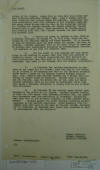
|
15.
February 3, 1930. G-2
Report on Activities of C. A.
Sandino in Mexico City, Col.
Gordon Johnston, Military
Attaché, p. 2.
"G-2 Report ¶ . . . office of
Dr. Zepeda. Among them on this
date were noted several
aviators, including Colonel
León. Also a recent arrival from
Nicaragua was noticed among the
callers. Apparently Sandino
entertained them with accounts
of his military exploits, and
among other things stating that
in the interview between Mr.
Stimson and General Moncada the
former presented General Moncada
with a gold medal, which,
according to Sandino, signified
nothing else than that General
Moncada had sold himself for
American gold. ¶ 5. A dinner was
given to Sandino on Jan. 31st,
by Guillermo Olivares, at Jalapa
70, in this city, which was
attended by his official family
and other friends. It is
reported that an American girl
was also among the guests; her
name is unknown. Sandino
announced that in the near
future he intended to publish
most sensational documents of
international interest, but
declined to say what the
contents were. ¶ 6. All the
staff of this Embassy are very
particular in not letting it
appear that they have any
interest in Sandino’s visit. No
direct communications with
military or civil authorities
have been held on the subject,
and no communications have come
to the Embassy from the Mexican
Government. ¶ 7. On February 1st
Sandino, accompanied by members
of his staff and Dr. Zepeda,
left the home of the latter at
10 o’clock in the morning and
went to the Balbuena aviation
field where a group of his
Mexican aviator friends awaited
him. Col. Gustavo León invited
Sandino for a flight over the
Valley of Mexico which he
accepted. Sandino, with Dr.
Zepeda and his friends, upon the
invitation of Col. León and
other Mexican aviators, went to
the town of Xochimilco where
they were given a banquet,
returning to Mexico City at six
o’clock that afternoon. ¶ 8. On
February 2d the special agent
called upon Sandino at the
office of Dr. Zepeda. Sandino
offered frankly to show him (the
agent) next Thursday, February
6th, his important documents
upon his activities in
Nicaragua, explaining that they
were as yet entirely unknown; he
also offered photographs.
Sandino passed the whole morning
dictating correspondence to his
private secretary. After
lunching with Dr. Zepeda they
both went to the home of General
Siurob, Governor of the
Territory of Quintana Roo, where
they remained an hour in
conversation with the Governor.
¶ Gordon Johnston ¶ Colonel,
Cavalry, ¶ Military Attaché. ¶
Source: Confidential. ¶ J/p ¶
From: M.A.Mexico. ¶ Report No.
2736. ¶ Date: Feb. 3, 1930."
This document translated
via the kind courtesy of Walter
C. Sandino. // Este
documento traducido a través la
amable cortesía de Walter C.
Sandino.
"Reporte G-2 ¶ " …
entre ellos en esta fecha, se
observaron varios pilotos,
incluyendo al Coronel León, como
también una reciente visita de
Nicaragua se pudo notar entre
los visitantes, aparentemente
Sandino los entretuvo con
anécdotas de sus incursiones
militares, y entre otras cosas
declarando que en la entrevista
entre el Sr. Stimson y el
General Moncada, el primero
obsequio al General Moncada con
una medalla de oro, la cual de
acuerdo con Sandino, tenía muy
poco significado, porque el
General Moncada se había
vendido, por oro americano.
¶ 5. Se le celebro a
Sandino una cena el 31 de enero,
por Guillermo Olivares, en
Jalapa, V. C. En esta
Ciudad fue atendido por su
familia oficial y otros amigos.
Es reportado que una muchacha
americana estaba entre los
invitados, su nombre es
desconocido. Sandino
anuncio que en el futuro cercano
él pretendía publicar documentos
sensacionales de interés
internacional, pero declino
decir cuáles eran sus
contenidos. ¶ 6.
Todo el personal de esta
Embajada es muy compartimentado,
en no dejar entrever de que
ellos tengan algún interés en la
visita de Sandino. No se
ha tenido reuniones con
autoridades militares o civiles,
ni comunicación respecto a este
tema, y no ha habido
comunicaciones enviada a la
embajada de parte del Gobierno
Mejicano. ¶ 7. El
primero de febrero Sandino,
acompañado por miembro de su
personal y el Dr. Zepeda,
abandonaron la casa de este
último a las 10 en punto de la
mañana y fueron al campo de
aterrizaje aéreo de Balbuena,
donde un grupo de aviadores
Mejicanos amigos de él, lo
esperaban. El Coronel
Gustavo León invito a Sandino a
volar sobre el Valle de Méjico,
el cual acepto. Sandino,
con el Doctor Zepeda y sus
amigos, ante la invitación del
Coronel León y los otros
aviadores mejicanos, fueron al
Pueblo de Xochimilco donde a
ellos se les brindo un banquete,
regresando a la Ciudad de Méjico
a las 6 en punto de esa tarde.
¶ 8. El 2 de febrero el
agente especial visito a Sandino
en la oficina del Dr. Zepeda.
Sandino con franqueza le ofreció
mostrarle a él (el agente) el
próximo jueves 8 de febrero sus
documentos importantes sobre sus
actividades en Nicaragua,
explicando que estas eran
totalmente desconocidas; él
también ofreció fotografías.
Sandino pasó toda la mañana
dictando correspondencia a su
secretario privado.
Después de almorzar con el Dr.
Zepeda los dos fueron a la casa
del General Siurob, Gobernador
del territorio de Quintana Roo,
donde permanecieron una hora en
conversación con el Gobernador.
¶ Fuente: confidencial.
Gordon Johnston, Coronel de
Caballería. Agregado
militar ¶ Desde:
M. A. México.
Reporte No. 2736. Fecha:
Feb. 3, 1930."
|
|
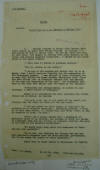
|
16.
January 31, 1930. G-2
Report on Activities of C. A.
Sandino in Mexico City, Col.
Gordon Johnston, Military
Attaché, Mexico City, p. 1.
"G-2
Report ¶ MEXICO ¶ SUBJECT:
Activities of C. A. Sandino in
Mexico City. ¶ 1. Sandino
arrived in Mexico City January
28th, 1930, coming by plane from
Mérida, Yucatán to Tejería,
V.C., and thence by rail to
Mexico City. He did not enter
the city of Vera Cruz. All
papers of January 29th carry
reports of his visit, and
several reported interviews. A
resumé of his statements to the
press follows: ¶ “I have come to
Mexico on personal matters.” ¶
“For us, Mexico is our school.”
¶ “I am now of the opinion, and
always will be to my death, that
I shall continue fighting for
the redemption of the Nicaraguan
people. I was obliged to leave
Nicaragua, but my army will
follow the plans already
determined upon. There are four
chiefs left in Nicaragua charged
with the custody of the arms and
ammunition of our army. You will
note that none of our arms have
fallen into the hands of our
enemies.” ¶ “Definitely and
categorically, in answer to your
question, I shall return to
Nicaragua.” ¶ Asked if he
understood how much influence
the United States had in Mexico,
he replied: ¶ “Not only here,
but in all parts of the world;
but everyone has the right to
clean out his own house.” ¶ “I
do not intend to visit people of
political importance in an
official character. Naturally,
however, I shall go to call upon
Calles, Sr. Portes Gil, and
Ortiz Rubio, to pay my respects
to them,- no more.” ¶ “Never for
a single moment have I abandoned
the patriotic cause of my
country, the triumph of which
the people of Nicaragua seek,
and are willing to continue
striving for, even at the cost
of the greatest sacrifices.” ¶
“We shall never stop until the
insolence of Uncle Sam has been
punished.” ¶ “Up to now, our
fighting for liberty has not met
with favorable response from the
Latin-American governments, but
it has among the people of those
countries.” ¶ Asked when he
would return to Nicaragua, he
replied: . . . ¶
From: M.A.Mexico. ¶ Report No.
2735. ¶ Date: Jan. 31, 1930."
This
document translated via the kind
courtesy of Walter C. Sandino.
// Este documento
traducido a través la amable
cortesía de Walter C. Sandino.
"Reporte G-2.
¶ Asunto: Actividades de
C. A. Sandino en la Ciudad de
Méjico ¶ 1.
Sandino arribo a la Ciudad de
Méjico el 28 de Enero, 1930
llegando por avión desde Mérida,
Yucatán a Tejerías, V.C. y
después por ferrocarril a la
Ciudad de Méjico. El no
entró a la ciudad de Veracruz,
todos los papeles del 29 de
enero llevan reportes de su
visita y varias entrevistas
reportadas, un resumen de sus
declaraciones a la prensa a
continuación: ¶ "Yo
he venido a Méjico por asuntos
personales" ¶ "Para
nosotros Méjico es nuestra
escuela" ¶ "Yo ahora
soy de la opinión y siempre lo
seré hasta el día de mi muerte,
que continuaré luchando por la
redención del pueblo
nicaragüense. Fui obligado
a abandonar Nicaragua, pero mi
Ejército seguirá con los planes
ya determinados respecto al
caso. Hay cuatro jefes que
se quedaron en Nicaragua
encargados de custodiar las
armas y municiones de nuestro
Ejército, ustedes pueden tomar
nota de que ninguna de nuestras
armas han caído en las manos de
nuestros enemigos." ¶
"Definitivamente y
categóricamente, en respuesta a
su pregunta, yo retornaré a
Nicaragua". ¶ Al ser
preguntando si él entendía
cuanta influencia tenía Estados
Unidos en Méjico, el contestó:
¶ "No solo aquí, sino que
en todas partes del mundo; todos
tienen el derecho de limpiar su
casa." ¶ "Yo no
pretendo visitar a
personalidades de importancia
política con carácter oficial.
No obstante, yo visitaré al Sr.
Calles, al Sr. Portes Gil, y al
Sr. Ortiz Rubio, para presentar
mis respetos a ellos, nada más."
¶ "Jamás, ni por un
momento he abandonado la cause
patriótica de mi País, el
triunfo que el Pueblo de
Nicaragua busca, y que está
dispuesto a continuar luchando
por ello, aún a costa del más
grande sacrificio". ¶
"Nosotros jamás nos detendremos
hasta que la insolencia del Tío
Sam, haya sido castigadas."
¶ "Hasta el momento,
nuestra lucha por la Libertad no
ha encontrado respuestas
favorables de los gobiernos
Latinoamericanos, sino de parte
de las personas de esos países."
¶ Al preguntársele cuando
el retornaría a Nicaragua el
contestó: . . . " ¶
Desde: M. A. México.
Reporte No. 2735. Fecha:
Ene. 31, 1930."
|
|
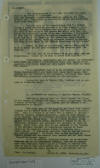
|
17.
January 31, 1930. G-2
Report on Activities of C. A.
Sandino in Mexico City, Col.
Gordon Johnston, Military
Attaché, Mexico City, p. 2.
"
. . . The circumstances in the
case will fix the exact date of
my return to Nicaragua. . . .
Our army has struggled against
the greatest power in the world,
without aid,, regardless of the
sacrifices and the sufferings
which they have met.” ¶ “At the
time of the negotiations with
the United States I first
thought of personally killing
Chamorro, Diaz, and Moncada, but
larer [later] thought that this
would bring about the useless
sacrifice of our people and
might have been construed as a
personal action of my own;
therefore I determined to take
upon my shoulders the entire
responsibility of the fight and
carry the banner of the
fatherland which Moncada had
cast to the ground, while he
occupied himself in rasping the
edge of his sword in the replete
money-bags of Uncle Sam.” ¶
Asked, in case of his triumph,
what he was going to do with
those who had sold themselves
for American gold, he replied: ¶
“If they come on their knees to
me, and weep, and ask
forgiveness, I would not be able
to order them killed.” ¶
“Furthermore, practically all
the people (of Nicaragua) even
under the present circumstances
where they appear to be
pacified, are really armed and
have hidden their arms in their
own houses.” ¶ “I am satisfied,
and it is my intuition, that in
the future America (Latin) and
Spain will clasp hands again,
forgetting all the effects of
the Conquest,- naturally when
Spain has another Government
substituted for the monarchy.” ¶
During his stay in Mexico City,
Sandino will be covered by a
special agent. ¶ 2. Movements
and actions of Sandino January
29, 1930. ¶ Sandino is staying
with Dr. Pedro Zepeda, who lives
at the corner of Ontario and
Alpes Streets, Chapultepec
Heights, a suburb of Mexico
City. Dr. Zepeda acts as
Sandino’s representative in
Mexico. ¶ The early part of the
morning was spent with Zepeda,
Estrada his so-called chief of
staff, his secretary Martinez,
etc. From 10 o’clock to 12 there
were a number of callers,-
personal friends, sympathizers,
etc.,- most of them unknown. It
is reported that no Government
officials or politicians of
importance were among them. At
12 o’clock Sandino, accompanied
by his personal party, deposited
a wreath at the Independence
Monument, and performed the
ceremony of Guard of Honor.
After this, they went to the
monument to the “Heroes of the
Military College” in Chapultepec
(graves of those killed by the
American troops during the
Mexican War). Agent states: “I
understand perfectly that he has
not visited any official
office.” He states that he had
enquired in various places and
was assured that Sandino had not
been there. ¶ (Report of Special
Agent.) ¶ M. A. is reliably
informed, however, by an
American business man of
unquestionable standing, who had
an appointment with President
Portes Gil at 1 o’clock on
January 29th, that he had to
wait until nearly two, in the
anteroom before his appointment
was kept; meanwhile, he saw
Sandino and Dr. . . .
¶ From: M.A.Mexico. ¶ Report No.
2735. ¶ Date: Jan. 31, 1930."
This
document translated via the kind
courtesy of Walter C. Sandino.
// Este documento
traducido a través la amable
cortesía de Walter C. Sandino.
"Reporte G-2 ¶
" . . . las circunstancias en el
caso, ajustaran la fecha exacta
de mi regreso a Nicaragua.
Nuestro ejército ha luchado
contra el poder más grande en el
mundo, sin ayuda … sin importar
los sacrificios y los
sufrimientos a los que ellos se
han enfrentado". ¶
"Al momento de las negociaciones
con los Estados Unidos,
primeramente pensé en matar
personalmente a Chamorro, Díaz y
Moncada, pero luego pensé esto
traería el sacrificio inútil de
nuestro pueblo y podría a haber
sido considerado como una acción
personal de mi parte: por
tanto determine echarme sobre
mis hombros la responsabilidad
entera de la pelea y cargar la
bandera de Madre Patria, la cual
Moncada había tirado al suelo,
mientras él se ocupaba en raspar
el filo de su espada en las
bolsas repletas de dinero del
tío Sam". ¶
Preguntado, en el caso de su
triunfo, que es lo que él iba
hacer con aquellos que se
vendían así mismo por oro
americano, el respondió: ¶
"Si ellos vienen sobre sus
rodillas a mí, llorando y piden
perdón, yo no podría ordenar que
ellos fuesen ejecutados".
¶ "Además prácticamente
todo el pueblo (de Nicaragua)
aún bajo las presentes
circunstancias donde parecen
estar muy pacíficos, ellos
realmente están armados y tienen
armamentos en sus propias
casas". ¶ "Yo estoy
satisfecho, y hasta en mi
intuición, que en el futuro
América (Latina) y España unirán
manos nuevamente, olvidando
todos los efectos de la
conquista. Naturalmente
cuando España tenga otro
Gobierno que sustituya a la
Monarquía". ¶
Durante su estadía en la Ciudad
de México, será cubierto por un
agente especial. ¶
2. Movimientos y acciones
de Sandino, 29 de enero de 1930.
¶ Sandino está hospedado
donde el Doctor Pedro Zepeda,
quien vive en la esquina de las
calles Ontario y Alpes, altos de
Chapultepec, un suburbio de la
Ciudad de Méjico, el Doctor
Zepeda es el Representante de
Sandino en Méjico. ¶
Temprano por la mañana la paso
con Zepeda, Estrada, su tal
llamado Jefe de su personal, su
secretario Martínez, etc...
De las 10 en punto a las 12 hubo
un buen número de visitantes;
amigos personales,
simpatizantes, etc... La
mayoría desconocidos. Se
reporto que no había entre ellos
oficiales del Gobierno o
Políticos de importancia.
A las 12 en punto Sandino,
acompañado por su comitiva
personal, deposita una guirnalda
en el Monumento de la
Independencia, participo en la
ceremonia de guardia de honor.
Después de esto fueron al
monumento de "los Héroes del
Colegio Militar" en Chapultepec
(las tumbas de aquellos caídos
en la guerra de Méjico por las
tropas americanas). ¶
El agente declara: "yo
estoy seguro que él no ha
visitado ninguna oficina de
oficiales". ¶ El
declara que ha preguntado en
varios lugares y se le aseguro
que Sandino no había estado ahí.
(Reporte de la agente especial).
¶ M. A. es un informante
confiable, sin embargo, un
hombre de negocios americano de
incuestionable reputación, quien
tenía una cita con el Presidente
Portes Gil, a la una en punto
del 29 de enero, dijo que tuvo
que esperar hasta casi las 2 pm,
en la ante sala antes de que si
cita fuera llevada a cabo;
mientras tanto, el vio a Sandino
y al doctor . . . " Desde:
M. A. México. Reporte No.
2735. Fecha: Ene. 31,
1930."
|
|
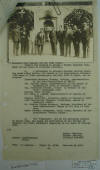
|
18.
January 31, 1930. G-2
Report on Activities of C. A.
Sandino in Mexico City (with
photo), Col. Gordon Johnston,
Military Attaché, Mexico City,
p. 3.
(
... transcription & translation continue below
... || ...
transcripción y
traducción siguen a continuación
... )
|
|
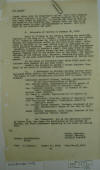
|
19.
January 31, 1930. G-2
Report on Activities of C. A.
Sandino in Mexico City, Col.
Gordon Johnston, Military
Attaché, Mexico City, p. 4.
"G-2
Report ¶ . . . Zepeda taken into
the President’s office, where
they remained for three quarters
of an hour. Sandino, appeared to
be in a very happy humor on
leaving. No mention was made of
this in the press of the
following day, January 30th, nor
was it apparently known to press
correspondents or others, that
this visit to the President was
paid. ¶ 3. Movements of Sandino
on January 30, 1930. ¶ Until 10
o’clock in the morning Sandino
was receiving visitors at the
home of Dr. Zepeda. At 10 he
went to the office of Dr.
Zepeda, at Balderas 24, where a
considerable number of friends
and sympathizers called on him
until about noon. After lunch he
returned to the same office,
where he continued to receive
numerous visitors. Agent was
informed by José Constantino
González, a member of Sandino’s
staff, that some forty or fifty
people had visited Sandino
during the day, counting among
them General Velasco (not on the
active list of the army), and
various officers of the Mexican
army, senators, deputies, and
some aviators. He was also
interviewed by correspondents of
various newspapers. ¶ At the
house of President-elect Ortiz
Rubio agent was informed that
Sandino had not been there. ¶
Sandino was invited to attend a
dinner tomorrow (Jan. 31st) at
the home of Guillermo Olivares.
¶ 4. A photograph is attached,
showing Sandino standing guard
after pacing the wreath on the
Independence Monument. The names
of those accompanying him, from
left to right, are as follows: ¶
Licenciado Maraviac Morteau,
Haitian, representative of the
Anti-Imperialists of Haiti. ¶
Col. Agustín Martí,
representative of the people of
Salvador, and chief of Sandino’s
staff. ¶ Gen. Francisco Estrada,
Second in Command of Sandino’s
Nicaraguan Army. ¶ Augusto Cesar
Sandino. ¶ Dr. Pedro J. Zepeda,
representative of Sandino in
Mexico. ¶ Esteban Pavletish,
Peruvian; member of Sandino’s
staff. ¶ José Constantino
Gónzalez, Nicaraguan, member of
Sandino’s staff. ¶ Dr. Enrique
Rivera Bertraud, Mexican;
President of the
Anti-Imperialistic League of the
city of Vera Cruz. ¶ Amado
Chaverri Matamoros, Costa Rican;
director of the publication
“Patria Grande”. ¶ 5. The
“Democrata”, one of the
afternoon dailies of Mexican
City, has begun the publication
of the history of Sandino, the
first instalment appearing in
the issue of January 30th. ¶ J/p
¶ Gordon Johnston. ¶ Colonel,
Cavalry, ¶ Military Attaché. ¶
Source: Confidential; ¶ Press. ¶
From: M.A.Mexico. ¶ Report No.
2735. ¶ Date: Jan. 31, 1930."
This
document translated via the kind
courtesy of Walter C. Sandino
// Este documento
traducido a través la amable
cortesía de Walter C. Sandino.
"Reporte G-2.
¶ "... Zepeda que eran
llevados a la oficina del
Presidente, donde permanecieron
por tres cuartos de hora.
Sandino parecía estar de buen
humor al salir. No hubo
mención sobre esto en la prensa
del siguiente día, 30 de enero,
ni tampoco fue conocido por los
corresponsales de la prensa
aparentemente, o algún otro, de
que se realizo esta visita al
Presidente. ¶ 3.
Movimiento de Sandino el 30 de
enero de 1930. ¶
Hasta las 10 en punto de la
mañana, Sandino estaba
recibiendo visitas en la casa
del Dr. Zepeda, en Balderas 24,
donde un considerable número de
amigos y simpatizantes lo
visitaron hasta el mediodía.
Después del almuerzo él regreso
a la misma oficina, donde
continuo recibiendo numerosos
visitantes. El agente fue
informado por José Constantino
Gonzales, un miembro del
personal de Sandino, que unas 40
o 50 personas habían visitado a
Sandino durante el día, contando
entre ellos al General Velasco
(no es de la lista activa del
Ejercito), y varios oficiales
del Ejército Mexicano,
cenadores, diputados y algunos
aviadores. El también fue
entrevistado por corresponsales
de varios periódicos. ¶
En la casa del Presidente electo
Ortiz Rubio, el agente fue
informado que Sandino no había
estado ahí. ¶
Sandino fue invitado a una cena
mañana (31 de enero) en la casa
de Guillermo Olivares. ¶
4. Una fotografía está incluida,
mostrando a Sandino haciendo
guardia de honor después de
poner la corona en el Monumento
de la Independencia. ¶
Los nombres de aquellos que lo
acompañan de izquierda a derecha
son: ¶ Lic. Maraviac
Morteau, Haitiano, Representante
de los Antiimperialistas de
Haití. ¶ Cnel.
Agustín Farabundo Martí,
Representante del pueblo del
Salvador y Jefe de personal de
apoyo de Sandino. ¶
Gral. Francisco Estrada, Segundo
al mando del Ejército de Sandino
en Nicaragua. ¶
Augusto Cesar Sandino. ¶
Dr. Pedro José Zepeda,
Representante de Sandino en
México. ¶ Esteban
Pavletich, Peruano, Miembro del
personal de apoyo de Sandino.
¶ José Constantino
Gonzales, Nicaragüense y miembro
del personal de apoyo de
Sandino. ¶ Dr.
Enrique Rivera Bertrand,
Mexicano, Presidente de la Liga
Antiimperialista de la ciudad de
Veracruz. ¶ Amado
Chaverri Matamoros,
costarricense, Director de la
publicación "Patria grande".
¶ 5. "El Democrata," un
diario vespertino de la ciudad
de Méjico, ha comenzado la
publicación de la historia de
Sandino, el primer artículo
aparecido en la edición especial
del día 30 de enero. ¶
J/P ¶ Fuente:
confidencial; ¶
Gordon Johnston, Coronel de
Caballería. ¶
Prensa. ¶ Agregado
militar ¶ Desde:
M. A. México. Reporte No.
2735. Fecha: Ene. 31,
1930."
|
|
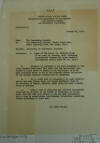
|
20.
January 31, 1930.
Confidential Report on Activities of Nicaraguan
Aviators, Gen. Logan Feland,
USMC, San Francisco, to CO Naval
Operating Base, San Diego CA.
"C_O_P_Y
¶ UNITED STATES MARINE CORPS ¶
Headquarters, Department of the
Pacific ¶ 100 Harrison Street ¶
SAN FRANCISCO, CALIFORNIA ¶
CONFIDENTIAL ¶ January 31, 1930.
¶ From: The Commanding General.
¶ To: The Commanding General,
Marine Corps Base, ¶ Naval
Operating Base, San Diego,
Calif. ¶ Subject: Activities of
Nicaraguan Aviators. ¶
Enclosure: 1. (Copy of MCG
letter No. 1975-35-15-AD-37 kk
dated 20 January, 1930,
including endorsements thereon
and Major Rowell’s confidential
report dated 28 Jan. 1930.) ¶ 1.
Original of enclosure 1 has been
forwarded to the Major General
Commandant this date, but the
information contained in Major
Rowell’s report is not
sufficient to be of much
practical value as far as the
possible future activities of
the Central American aviators
may be concerned. ¶ 2. It is
noted that in paragraph 4 of
Major Rowell’s report two men:
Efraim Trava and Alonzo
Garibaldi claim to be residents
of Merida, Yucatan, which place
has been a recent abode of
Sandino. ¶ 3. With a view to
obtaining all possible
information which may be of
value to our forces in
Nicaragua, it is desired that
you take such action as you may
deem appropriate with a view to
ascertaining intelligence
information concerning future
intentions of these men. ¶ /s/
LOGAN FELAND."
|
|
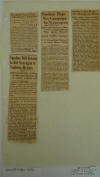
|
21.
January-February 1930.
Press clippings: Jan
28: "Sandino Planning to Return
To Continue Fight on 'American
Oppression,' Ex-Rebel Says at
Mexico City, New York Sun.
Jan 29: "Sandino Maps New
Campaign In Nicaragua," New
York Tribune.
Jan 29: "Sandino Will Return to
Rid Nicaragua of Yankees, He
Says," Washington News.
Feb 7: "Sandino to Quit Mexico
For Nicaragua by March," New
York Herald Tribune.
"SANDINO PLANNING
NICARAGUA RETURN ¶ To Continue
Fight on “American Oppression,”
Ex-Rebel Says at Mexico City
¶ MEXICO CITY, Jan. 28
(AP).—Augustino Sandino, former
Nicaraguan insurgent leader,
arrived in Mexico City today
from Vera Cruz. He told Mexican
newspaper men that he planned to
return to Nicaragua at an early
date to carry on his campaign
against “American oppression,”
saying he had 2 000 loyal
followers awaiting his return
and that he would take up his
campaign where he left off last
June. ¶ Sandino was found riding
in a day coach. “This is how I
am spending that $60,000 the
newspapers say I was paid to get
out of Nicaragua.[“] ¶
Sandino Will Return to Rid
Nicaragua of Yankees, He Says ¶
Undismayed by Failure of Plans
for Welcoming Reception as He
Arrives in Mexico City
¶ By United Press ¶ MEXICO
CITY—“Gen.” Agustino Sandino, a
small, thin man wearing a grey
sombrero and wrinkled civilian
clothes, has arrived in Mexico
City with the announced purpose
of returning to Nicaragua and
freeing that country from
“Yankee tutelage.” ¶ He was
undismayed by the complete
failure of plans for a welcoming
reception at the railroad
station here. ¶ He declared
himself confident of ultimate
success in his campaign against
the government of President
Moncada of Nicaragua, which he
said was merely postponed when
he fled to Merida, Yucatan, last
year after having led the U. S.
Marines a merry chase for months
thru the Nicaraguan wilderness.
¶ His mission in Mexico City, he
said, is connected with his
plans to return and resist the
“invaders.” ¶ Sandino had sat up
all night in a day coach during
the ride from Vera Cruz. The
“General” cited his inexpensive
mode of travel as disapproving
charges that he had accepted a
bribe to leave Nicaragua. ¶
“Nicaragua wants to be rid of
the Yankees,” he declared. “They
prefer liberty to the illusory
riches President Moncada offers.
When the time comes we will
capture Managua with the loyal
followers who are now awaiting
the moment to strike.” ¶
Sandino Maps New Campaign In
Nicaragua ¶ Rebel Chief Arrives
in Mexico City to Complete
Revolt Plans Against
Moncada ¶ Assails ‘Yankee
Tutelage’ ¶ U. S. ‘Flying
Clinic’ Honored at Costa Rican
Capital ¶ By The United
Press ¶ MEXICO CITY, Jan.
28.—“General” Augustino Sandino,
a small, thin man wearing a gray
Texas sombrero and wrinkled
civilian clothes, arrived in
Mexico City today with the
announced purpose of returning
to Nicaragua and freeing that
country from “Yankee tutelage.”
¶ He was undismayed by the
complete failure of the plans
started for a welcoming
reception at the railroad
station here. ¶ Declaring
himself confident of ultimate
success in his campaign against
the government of President
Moncada of Nicaragua, he said
things had been merely postponed
when he fled to Merida, Yucatan,
last year after having led the
United States Marines a long
chase through the Nicaraguan
wilderness. ¶ “Nicaragua wants
to be rid of the Yankees,” he
declared. “They prefer liberty
to the illusory riches President
Moncada offers. When the time
comes we will capture Managua
with the loyal followers who are
now awaiting the moment to
strike.” ¶ He declared the
proposed Nicaraguan Canal is
merely a United States plan to
establish a naval base in
Nicaragua. ¶ Sandino was
enthusiastic about his trip
yesterday over the Pan-American
Airways Line from Merida to Vera
Cruz. It was his first flight. ¶
Sandino to Quit Mexico
For Nicaragua by March ¶ Rebel
Leader Continues Talks With
Independence Groups ¶
By Cable to the Herald Tribune ¶
Copyright, 1930, New York
Tribune Inc. ¶ MEXICO CITY, Feb.
8.—General Augustino Sandino,
the Nicaraguan rebel leader,
will return to Merida soon after
February 15, according to his
present plans. Since his arrival
here toward the end of January,
he has devoted his attention to
stimulating the propaganda in
favor of his cause, receiving
dainly [daily] a not
insignificant flow of visitors
at the office of Dr. Pedro J.
Zepeda, his local
representative, where he has
made his headquarters. ¶ One of
the Nicaraguan patriot’s first
acts upon his arrival was to
visit Mexico’s Independence
Monument, where he placed a
wreath of flowers on the tomb of
Father Hidalgo, Mexico’s George
Washington. Yesterday Sandino
and a group of his followers
called at the monument again and
placed a porcelain floral
tribute as a more lasting
offering, wrapped in the
Nicaraguan flag, on the vault
containing Father Hidalgo’s
bones, together with the
inscription: “With all respect
and admiration for the
invincible Hidalgo and other
heroes of Mexican
independence—Sandino, Zepeda.” ¶
During his stay here, General
Sandino has rarely been
available in the early mornings,
rising generally about noon,
which has served to strengthen
the report that such conferences
as he has held with his
sympathizers, the majority of
whom are of the student type,
have taken place at night."
|
|
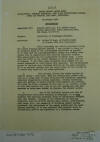
|
22.
January 28, 1930. Confidential
Memorandum on Activities of
Nicaraguan Aviators, Major Ross
E. Rowell, USMC Headquarters
Aircraft Squadrons, West Coast
Expeditionary Forces, Naval Air
Station, San Diego CA, to Col.
Harry Lay, USMC San Diego CA, p.
1.
"C
O P Y ¶ UNITED STATES MARINE
CORPS ¶ HEADQUARTERS, AIRCRAFT
SQUADRONS, WEST COAST
EXPEDITIONARY FORCES, ¶ NAVAL
AIR STATION, SAN DIEGO,
CALIFORNIA ¶ 28 January 1930. ¶
CONFIDENTIAL ¶ Memorandum for:
Colonel Harry Lay, U.S. Marine
Corps, ¶ Marine Corps Base,
Naval Operating Base, ¶ San
Diego, California. ¶ Subject:
Activities of Nicaraguan
Aviators. ¶ Reference: (a)
Letter CG Dept. of Pacific dated
20 January 1930 with enclosures.
¶ 1. While conducting the aerial
operations during the recent
campaign against Sandino, I was
obliged to carry on an intensive
study of the intelligence
activities in general. It is
true that the Anti-Imperialistic
League was closely associated
with an organization that
actively supported Sandino. This
organization has its
headquarters in Mexico City. I
note that the writer of the
letter expected to be in Mexico
City on 10 January. I note from
press dispatches that Sandino
has received permission to visit
Mexico City recently. The
circumstances appear to indicate
some continued activity by the
same personnel. It is my
personal opinion that the major
object of the society is to
secure easy money for the prime
agitators. ¶ 2. The enclosed
letters are rather typical of
several others I have seen. They
are usually well padded with
lies as to large sums of money
available and falsehoods
regarding elaborate preparations
already completed. Sandino
habitually used such methods to
secure recruits from Honduras
and Salvador. In noting the
final paragraph of this memo it
is, however, worthy of note that
Sandino and a few of his old
leading men have been reported
as being near Merida, in
Yucatan, for several months. ¶
3. Due to the difficult terrain
and lack of transportation
facilities existing in
Nicaragua, it is very unlikely
that military airplanes could be
successfully smuggled into that
country. Because of the
difficulty of securing
armaments, such as aircraft
machine guns, mounts,
synchronizers, bomb racks, etc.,
the necessity of obtaining
highly trained personnel, the
seriousness of the supply
problem and the heavy expense
involved, it is very unlikely
that aircraft could be
successfully used by any
expedition of a filabuster
[filibuster] nature. . . . "
|
|
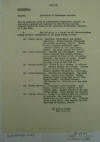
|
23.
January 28, 1930. Confidential
Memorandum on Activities of
Nicaraguan Aviators, Major Ross
E. Rowell, USMC Headquarters
Aircraft Squadrons, West Coast
Expeditionary Forces, Naval Air
Station, San Diego CA, to Col.
Harry Lay, USMC San Diego CA, p.
2.
"C_O_P_Y_
¶ CONFIDENTIAL ¶ Subject:
Activities of Nicaraguan
Aviators. ¶ . . . Such an
operation could be successfully
undertaken, perhaps, if
completely equipped and
organized in some foreign
country, secretly landed and
based on the territory of
Honduras, Salvador, or C osta
Rica [Costa Rica]. ¶ 4. The
following is a report on all
Latin-Americans taking aviation
instruction in San Diego flying
schools. ¶ (a) Efraim Trava:-
Educated, intelligent, and
appears well-to-do. Claims
Mexican citizenship and resides
in Merida, Yucatan. Claims to be
a Chrysler automobile agent.
Student aviator at T.C. Ryan
Flying School. San Diego address
449-57th St. ¶ (b) Alonzo
Garibaldi: Educated and
intelligent. Claims to be a
Mexican from Merida, Yucatan,
and a partner of Trava in the
automobile business. Has plenty
of money. Student aviator at
T.C. Ryan Flying School. San
Diego address: 480-63rd St. ¶
(c) Gonzalo Grabbell:- Claims to
be a Mexican. Is well-to-do.
Mexican address not learned.
Student aviator at T.C. Ryan
Flying School. Present address:
765-10th St., San Diego. ¶ (d)
Carlos Palencia:- Educated and
intelligent. Has ample funds.
Claims to be Chilian [Chilean].
Taking advanced flying
instruction at T.C. Ryan Flying
School. San Diego address; 1880
Kearney St. This man is a very
good flyer. ¶ (e) Enrico
Castino:- Intelligent
Latin-American. Ample funds.
Claims to be a Captain in the
Mexican Army. Student aviator at
Air Tech Flying School. Local
address not learned. ¶ (f)
Latones Batres:- Claims to be
Mexican from the vicinity of
Mexicali. Has completed aviation
instruction in some school here.
Reported to be a good pilot. Now
employed by Jack Thornburg at
Phoenix, Arizona. ¶ /s/ Ross E.
Rowell ¶ Maj. U.S.M.C."
|
|
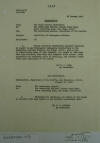
|
24.
January 20, 1930.
Confidential Memorandum on
Activities of Nicaraguan
Aviators, USMC Major General
Commandant John A. Lejeune to CO
USMC Naval Operating Base, San
Diego CA.
"C_O_P_Y
¶ 1975-35-15 ¶ AD-37-kk ¶ 20
January 1930. ¶ CONFIDENTIAL ¶
From: The Major General
Commandant. ¶ To: The Commanding
Officer, Marine Corps Base, ¶
Naval Operating Base, San Diego,
Calif. ¶ Via: The Commanding
General, Department of the
Pacific. ¶ Subject: Activities
of Nicaraguan aviators. ¶
Enclosures: (2) ¶ 1. Please
institute immediately discreet
inquiries in regard to any
Nicaraguans undergoing
instructions at the Commercial
Aviation Schools, San Diego,
Calif., with a view to
ascertaining names of such
students, the length of time
they have been enrolled, when
they will complete their course,
their occupation and residence
prior to enrolling, and probable
intentions upon completion of
the course. ¶ /s/ D. P. HALL, ¶
By direction. ¶ 1st Endorsement.
¶ Headquarters, Department of
the Pacific, San Francisco,
Calif., ¶ January 25, 1930. ¶
From: The Commanding General, ¶
To: The Commanding Officer,
Marine Corps Base, ¶ Naval
Operating Base, San Diego,
California. ¶ 1. Forwarded for
compliance and return of all
papers by air-mail with your
report at the earliest
practicable date. ¶ /s/ F. D.
KILGORE ¶ By direction."
|
|
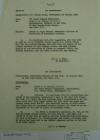
|
25. January 20,
1930. 1st Endorsement of
Letter of Major Gen. Commandant
Lejeune Relative to Activities
of Nicaraguan Aviators, to Major
J. D. Murray, USMC, New York
City, and 2nd Endorsement
(Report) by Major Murray, NY
City.
"C_O_P_Y
¶ AD-37-kk ¶ 1st Endorsement. ¶
Headquarters U.S. Marine Corps,
Washington, 20 January 1930 ¶
From: The Major General
Commandant. ¶ To: Major J. D.
Murray, U.S.M.C., ¶
Headquarters, District of New
York, ¶ 18 East Twenty-third
Street, ¶ New York, N.Y. ¶
Subject: Letter to Major General
Commandant relative to
activities of Nicaraguan
aviators. ¶ 1. In accordance
with your suggestion, you will
take up with Mr. E. H. Brainard,
former Major, U.S. Marine Corps,
now with the Curtiss Company,
New York City, the matter of the
alleged purchase of five Curtiss
planes, and make further inquiry
of the activities of Lisboa at
Roosevelt Field, the Chilean
Consulate, and any other sources
that may develop. ¶ /s/ D. P.
HALL, ¶ By direction. ¶ 2nd
Endorsement. ¶ Headquarters,
Recruiting District of New York,
31 January 1930. ¶ 18 East 23rd
Street, New York, N.Y. ¶
CONFIDENTIAL ¶ From: Major J. D.
Murray, U.S.M.C. ¶ To: The Major
General Commandant,
Headquarters, ¶ U.S. Marine
Corps, Washington, D.C. ¶ 1.
Returned. In compliance with the
instructions contained in the
preceding endorsement I went to
323 West 30th Street, New York,
N.Y. where the same landlady
whom I interviewed on my
previous visit said that Miguel
Lisboa had left about two weeks
previously owing about $24.00.
The Consulate General of Chile
stated that Lisboa had not
registered another address, and
there is no one registered by
the name of Lisboa at Roosevelt
Field. ¶ 2. Mr. Edwin H.
Brainard’s assistant, Mr. Day,
at the Curtiss-Wright Flying
Service, 27 West 57th St., New
York, N.Y. called me to say that
my inquiry had been forwarded
from Major Brainard (now in
Chicago), for investigation, and
stated positively that no planes
had been sold to any Central
American parties as far back as
he could recall. ¶ /s/ J. D.
Murray."
|
|
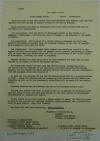
|
26.
Saturday, January 4, 1930.
Letter from R. Puenzalida, G.,
Managua, to Lt. Manuel Lopez
Osorio, Hotel Miami FL, and Sgt.
Humberto Donozo, Liga
Anti-Imperialista de America.
"(COPY) ¶ Dr. José.
A.P.R. ¶ Señor Manuel
López, Osorio. Aeronautics.
¶ Four airplanes of the
most modern type well equipped
with machine guns and bomb
carriers for the service of
defense valued at the sum of
$98,000. ¶ These
machines have been in Nicaraguan
territory since October 1929 and
are divided up for expeditions.
¶ 1st expedition: From the
State of Chinandega across to
San Marcos - to Sugagapa -
Chinandega - crossing the Lake
of Managua - and stopping at San
Roque or Brazil. ¶
2nd expedition: Will consist of
a better defense equipment and
will take place in the State of
Granada near the Mombacho
Volcano or the city of Granada.
This expedition will join the
first. ¶ 3rd
expedition: Will penetrate Nueva
Segovia as closely as possible
to the capital and will be in
touch with the general staff;
general quartering of troops
will be found near the Cookra
River and will be distributed as
far as the Lagoon of Bluefields.
(Meaning not clear in original)
¶ General Sandino has been
fully aware of this movement but
will take no part because he is
unable to attack the Yankee
marines. ¶ The funds
will amount to more than one
million pesos, collecting daily,
the attack will be composed of
two divisions, the first
division will attack Managua,
and the second the North
American marines by machine gun
and bombardment with the
squadron which will consist of
¶ We have all the elements
of war for the attack which will
be a surprise attack by night.
Among the constabulary of
Managua we have various men for
secret information as well as in
the government; everything will
be ready for the coming season.
¶ The only obstacle are
the marines who are to be
attacked without pity. ¶
You and your friend wish to come
to see us to discuss the
position which they are going to
take and that they present to
you this letter as countersign.
(Construction of original not
clear). ¶ If you
assist us you will receive a
large amount of money, all that
you want; we have in our service
two American aviators, under
contract, and a Spanish boy,
about 15 good pilots. Long
live liberty! ¶ Don
José will tell you everything.
Order Adjutant. ..."
|
|
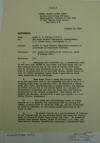
|
27.
January 10, 1930.
Confidential Report by Major J.
D. Murray, USMC, New York City,
to the Major Gen. Comandant,
USMC Washington, on Activities
of Nicaraguan Aviators, p. 1.
"C_O_P_Y
¶ UNITED STATES MARINE CORPS ¶
Eastern Recruiting Division ¶
Headquarters, District of New
York ¶ 18 East Twenty-third
Street ¶ New York, N.Y. ¶
January 10, 1930. ¶ CONFIDENTIAL
¶ From: Major J. D. Murray,
U.S.M.C. ¶ To: The Major General
Commandant, Headquarters, ¶ U.S.
Marine Corps, Washington, D. C.
¶ Subject: Letter to Major
General Commandant relative to
activities of Nicaraguan
aviators. ¶ Reference: (a)
Letter MGC #1975-35-15
A-159-mve, dated 8 January 1930.
¶ Enclosure: (1) ¶ 1. Complying
with reference (a), I
immediately went to 323 West
30th Street in this City, and
upon being told by the landlady
that no one by the name of
Osorio lived there left an
unsigned note addressed to Mr.
M. L. Osorio, stating that if he
would call at 18 East 23rd
Street, fourth floor, or call
the office telephone number
which I gave him he might learn
something to his advantage. ¶ 2.
Some hours later a young man
brought the note to me and
explained that it was expedient
for him to live at a boarding
house under an assumed name. He
showed me a letter dated July
1928, identifying him as Miguel
Lisboa, and stating in effect
that he was in the United States
as a student of aeronautical
navigation and that any favor
done him would be appreciated by
the Chilean government. This
letter was in English and
Spanish, stamped with a seal and
signed-----------David, Chilean
Ambassador. ¶ 3. This young man
unfortunately spoke as little
English as I do Spanish, but
emphasized that in writing the
letter, a translation of which
you sent me, and the authorship
of which he admitted, he was
acting solely according to his
sense of duty. ¶ 4. He stated
that he is a Sub-Lieutenant of
Infantry in the Chilean Army now
on aviation detail and works and
studies daily at Roosevelt
Field, Long Island, New York. He
showed me letters from General
Fechet, Chief of Aviation, U.S.
Army, and from Senator Bingham,
Connecticut, regarding a
stabilizer which . . . "
|
|
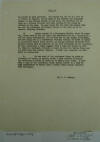
|
28.
January 10, 1930.
Confidential Report by Major J.
D. Murray, USMC, New York City,
to the Major Gen. Comandant,
USMC Washington, on Activities
of Nicaraguan Aviators, p. 2.
"C_O_P_Y
¶ . . . he claims to have
invented. His manner was not at
all that of a ‘crank’ or
fanatic, and he gave me the
address and telephone number of
the Chilean Consul in New York,
who verified him by name as a
Chilean citizen, but knew
nothing of his being an officer
in the Army. He goes there for
his mail the Consul told me over
the telephone and simply stated
to him that he is in America
studying aviation. ¶ 5. Lisboa
speaks of a Nicaraguan Doctor,
about 38 years old, whose name
he did not know, but described
him as a “capitalist’, and two
young Nicaraguans, all of whom
are in San Diego, California,
the two young men in a
Commercial Aviation School. He
spoke of Doctor or Lieutenant
Manuel Lopez Osorio, as having
recently purchased five Curtiss
planes here in addition to the
four mentioned in the enclosure.
In this connection I might
suggest that I take the matter
up with Mr. Edwin H. Brainard,
formerly a Major in the U.S.
Marine Corps and now here with
the Curtiss Company. I shall
not, however, do this until so
instructed. ¶ 6. On one card of
the enclosure there is given an
itinerary of Lopez, or Osorio,
which I have labeled in pencil
and according to which he would
be in Mexico City today. I have
made a copy of the enclosure,
which Lisboa states is a copy he
made unbeknownst to Osorio from
a letter which Osorio received
from Nicaragua. ¶ /s/ J. D.
Murray."
|
|
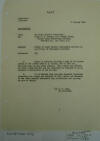
|
29.
January 8, 1930.
Confidential letter from Major
Gen. Comandant, USMC, Washington
D.C. to Major J. D. Murray,
USMC, New York City, re
Confidential letter from M. L.
Osorio, New York City, to US
Navy Department, Washington D.C.,
re Activities of Nicaraguan
Aviators.
"C_O_P_Y ¶ 1975-35-15 ¶
A-159-mve ¶ 8 January 1930. ¶
CONFIDENTIAL ¶ From: The Major
General Commandant. ¶ To: Major
J. D. Murray, U.S. Marine Corps,
¶ Marine Corps Recruiting
Station, ¶ 186-23rd St., New
York, N.Y. ¶ Subject: Letter to
Major General Commandant
relative to activities of
Nicaraguan aviators. ¶
Enclosure: (1) ¶ 1. There is
enclosed herewith a copy of the
translation of the letter from
M. L. Osorio, 323 W. 30th St.,
New York City, on the above
subject. This letter was written
in rather crude Spanish and the
enclosure is believed to be as
accurate a translation as can be
made. ¶ 2. It is desired that
you make discreet inquiries
concerning the origin and
contents of this letter and
transmit to the Major General
Commandant any information that
you may be able to obtain. ¶ /s/
D. P. HALL, ¶ By direction."
|
|
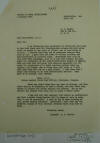
|
30. January 3, 1930.
Confidential letter from M. L.
Osorio, New York City, to US
Navy Department, Washington D.C.
"C_O_P_Y ¶ OFFICE OF NAVAL
INTELLIGENCE ¶ 3 January 1930. ¶
TRANSLATION: EMS ¶ COPY: MPS ¶
M. L. Osorio ¶ 323 W. 3th [30th]
St., ¶ N. Y. C. ¶ Navy
Department, U.S.A. ¶ Dear Sir: ¶
I am addressing your department
to inform you that here in New
York there were two
distinguished persons who were
going about in search of new
types of planes, one of them
being an aviator. I believe that
they had no passports because
they came by air. I gave them
the names of various salesmen
and representatives of aircraft
firms. Afterwards they told me
they were from Nicaragua, that
is to say from Managua and were
under the protection of the
Anti-imperialistic League of
America. They now have four
airplanes with complete
equipment are under the
instruction of a North American
aviator from Los Angeles,
California, who is being very
well paid; if I will join them
they will pay me a good salary.
I told them that I could have
nothing to do with international
matters. They gave me 50
dollars, this address: ¶ Tore,
A.P.R. ¶ Correo central (Main
Post Office), Nicaragua,
Managua. ¶ These men about three
days ago went to Chicago, and
from there they go to Pensacola
to meet a friend, and from there
they return to prepare the
attack against the Marines. You
do not realize the program they
have, not to leave a Marine
alive. ¶ I beg that you will
consider this matter as
confidential and that a minute
investigation will be begun at
once in order that it may be
successful. I wish no one to
know anything of this matter
besides yourself. Afterwards I
will send you the complete
program of this military
movement which they have in
hand. ¶ Sincerely yours, ¶
(Signed) M. L. Osorio."
|
|
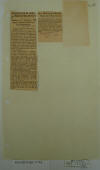
|
31.
December 15, 1931 & January 1,
1932. News clippings:
Dec 15: "Restoration of Army
Asked in Nicaragua,"
New York Times.
Jan 1: "Five Nicaraguan Rebels
Slain in 2 Encounters,"
Washington Post. "RESTORATION
OF ARMY ASKED IN NICARAGUA ¶
Chambers of Commerce Tell Hoover
National Guard Can’t Cope With
Outlaws. ¶ Special to The New
York Times. ¶ WASHINGTON, Dec.
14.—Coincident with a renewal of
outlaw activity in Northwestern
Nicaragua, the Chambers of
Commerce in Managua and Leon
have sent petitions to President
Hoover through the State
Department asking that
permission be granted for the
establishment of a national army
in Nicaragua. These appeals have
been acknowledged, through the
United States Legation in
Managua, without discussing
their merits or signifying the
attitude of this government. ¶
When Colonel Henry L. Stimson,
as the representative of
President Coolidge, brought the
Nicaraguan revolutionary
movement to a close by a truce
in 1928, it was agreed that
there should be no national army
in Nicaragua but a national
guard merely for police
purposes. It was believed that
this would make less possible
future outbreaks of rebellion
through the presence of a
national army that might be
manipulated for political
purposes. There has been no
indication that the United
States has since changed its
views favoring a national guard
exclusively. ¶ Since the warfare
with outlaws was resumed
recently the National Guard has
been temporarily strengthened
through the enlistment for short
terms of 300 “auxiliaries.”
Advices have indicated that the
reinforced guard would be
sufficient to cope with the
situation. ¶ The arms that were
laid down by both sides in the
truce of 1928 were delivered
into the custody of the National
Guard, according to Marine
Headquarters here. As far as is
known the guard has the use of
them. ¶ Five Nicaraguan
Rebels Slain in 2 Encounters
¶ Managua, Nicaragua, Dec. 31
(U.P.). Two engagements between
insurrectionists and National
Guard patrols commanded by
American officers occurred near
El Chipote today. ¶ Five rebels
were killed and many wounded,
one of the latter being Rafael
Altimarino, a member of
Augustino Sandino’s staff.
Sandino was reported retreating
toward the Coco River."
|
|
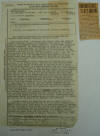
|
32.
December 29, 1931. G-2 Report
on Movements & Activities of
Nicaraguan Bandits in Nicaragua,
Major Fred. T. Cruse, Military
Attaché, Tegucigalpa, with news
clipping from Washington
Herald, Jan. 16, "Sandino
Force Slays Marine."
News
clipping:
"A U.S. Marine officer was
reported among heavy casualties
marking the defeat of Nicaraguan
bandits by national guardsmen on
the Coco River sector, advices
from Bluefields, Nicaragua,
today stated. ¶ The
battle occurred yesterday with
the guardsmen fiercely attacking
the river rendezvous where Gen.
Augusto Sandino's rebel
followers were concentrating for
a drive along the Atlantic
seaboard. ¶ During
the encounter an airplane,
believed to have flown out of
Mexico, operated with the
Sandinistas."
Intelligence Report:
"The following information was
received by letter from Dr.
Alejandro Cerda Guillen,
Nicaraguan living in Danlí: ¶
About December 10th, a messenger
from Sandino named Inez Perez of
Jicaro, Nicaragua, brought
correspondence from Sandino to
Alfonso Irias and Jose Idiaquez
(Danli, Honduras). He came
direct from their General
Encampment. The correspondence
was dated in “El Chipotón”.
According to the messenger “El
Chipotón” is three miles from
“El Naranjal”, from which point
you go down to the Murra river
and the mountain peak which you
see directly in front of you is
“El Chipotón”. The messengers
from Sandino take the following
route: From “El Chipotón[“] they
go to “San Geronimo” where they
spend the night at the Garcia
house; from there they proceed
to the house of Juan Pablo
Bellorin on the border resting
there the second night;
proceeding from there to Danlí.
¶ In the correspondence which
Sandino sent to Idiaquez there
was a statement to the foreign
press. This and all other
correspondence that comes from
Sandino is deposited in the post
office of Danli. ¶ This
messenger stated that Sandino
received arms and ammunition of
war by way of Cabo Gracias á
Dios, and that he now has a good
armament to realize an
offensive. The same messenger
stated that in Matagalpa,
Jinotega, Esteli and Nueva
Segovia they have very good
friends and that they are better
off than the Guardia because
they bring them food, clothes
and do not betray them, and that
in those departments they have
imposed contributions and that
practically all have been paid.
In Ocotal the following paid
$1,000.00: Cipriano Vilchez,
Justo Pastor Lovo, Arturo
Garmendia of Somoto who they
consider as one of their best
friends as he not only pays the
annual contribution but also
sends them clothes. They put
Toribio Quiñonez down for
$1,000.00 which, to date, he has
not paid, but they are confident
he will pay it for fear they
will capture and behead him or
impose a larger contribution. ¶
The last time that Juan Gregorio
Colindres passed by the town of
San Fernando, stated the
messenger, all the people came
out to offer their services
unconditionally and food, asking
him not to enter as that act
would compromise them with the
Guardia. Cerda states that
undoubtedly Sandino has wounded
men in his camps as he saw the
messenger come out of the house
of Dr. Zambrano with medicines.
¶ A letter bearing the signature
and seal of Sandino which is
probably one of the letters
referred to in the second
paragraph was shown by Mario
Rivas, local agent of the
Associated Press, to Sergeant
Kessler, the clerk in this
office. In this letter Sandino
stated that he would
concentrate, rest and re-equip
all his troops for an offensive
into the interior of Nicaragua
during the months of January,
February and March, 1932, with
the object, if the offensive is
a success, of attacking the city
of Managua, Nicaragua, on 9
April, 1932."
[News
clipping:]
SANDINO FORCE SLAYS
MARINE ¶ COLON, Panama,
Jan. 15 (U.S.).—A U. S. Marine
officer was reported among heavy
casualties marking the defeat of
Nicaraguan bandits by national
guardsmen on the Coco River
sector, advices from Bluefields,
Nicaragua, today stated. ¶ The
battle occurred yesterday with
the guardsmen fiercely attacking
the river rendezvous where Gen.
Augusto Sandino’s rebel
followers were concentrating for
a drive along the Atlantic
seaboard. ¶ During the encounter
an airplane, believed to have
flown out of Mexico, operated
with the Sandinistas."
|
|
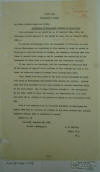
|
33.
December 21, 1931. G-2 Report
on Activities of Nicaraguan
Refugees in Costa Rica, Major A.
R. Harris, Military Attaché, San
José.
"COSTA
RICA ¶ POPULATION & SOCIAL ¶ No.
2700 – Public Order and Safety.
¶ Activities of Nicaraguan
Refugees in Costa Rica. ¶ With
reference to our report No. 4,
of December 14th, 1931, the
following article appeared in
the Diario de Costa Rica of
December 20th, 1931:-- ¶ “On
account of knowledge which the
Government of Costa Rica has
that various Nicaraguans are
organizing in this country in
order to return to Nicaragua to
join the forces of Sandino, the
necessary measures have been
taken to prevent their doing so
and to guarantee the neutrality
of the Government of Costa Rica
in accordance with the
Washington Treaties. ¶ It has
come to our knowledge that the
Government of Nicaragua knew of
the designs of many of their
citizens in this country and
that it has taken the necessary
steps to prevent their leaving
Costa Rica. ¶ Also, orders have
been given by the Costa Rican
Government to watch this group
of Nicaraguans and prevent them
leaving the country. Already
many have been detained and have
been ordered to present
themselves daily to the
authorities. One of them,
Guillermo Zeledón R., who
accompanied by his wife, tried
to leave the country, was
imprisoned for some hours and
later set at liberty on his
promise to report to the
authorities every day. ¶ Also we
are informed that on the North
Frontier, no Nicaraguan who
cannot show that his leaving the
country is for other reasons
than joining Sandino’s forces,
will be permitted to leave.” ¶
Report No. 12 ¶ San José,
December 21, 1931¶ Source –
Newspapers. ¶ A. R. Harris, ¶
Major, G.S. ¶ M.A."
|
|
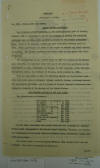
|
34.
December 16, 1931. G-2
Report on Latest Bandit
Activities, Major A. R. Harris,
Military Attaché, San José, p.
1.
"NICARAGUA
¶ POPULATION & SOCIAL ¶ No. 2700
– Public Order and Safety. ¶
Latest Bandit Activities. ¶ The
following article appearing in
the Diario de Costa Rica of
Tuesday, December 15th is
forwarded to G-2 for the purpose
of showing the amount of
publicity that is being given in
Central America to the Sandino
operations. Note: While in El
Salvador I found the same
conditions existing there as
here. Every opportunity was
taken by the papers to exploit
any small success of Sandino.
The Guardia successes were never
given or were given very small
notices:-- ¶ “In confirmation of
the notices which we have been
giving of the Nicaraguan
situation, we reproduce today
the map of the military
operations in the Departments of
Leon, Chinandega and Managua of
that Republic, taken from the
Moncardista Diario, “LA NOTICIA”
of Managua, dated December 2,
1931. ¶ From the same paper we
give the following details of
the principal combats which took
place in November between
Sandino’s forces, scattered
through the Departments
mentioned, and the forces of
General Moncada’s Government
commanded by Sergeants of the
Marines of the United States. ¶
THE FOURTEEN COMBATS OF THE PAST
MONTH ¶ The combats were as
follows:-- ¶ Los Arados – on
November 1, 1931 ¶ La Laguna “ “
9, 1931 ¶ Las Cañas “ “ 11, 1931
¶ San Juan de Telpaneca 15, 1931
¶ Las Vegas on “ 20th 1931 ¶
Moyocunda on “ 25, 1931 ¶ Las
Escarbaderos “ 26, 1931 ¶ La
Cenicera “ 26, 1931 ¶ Valla de
las Zapatas “ 28, 1931 ¶ El
Cuadro “ 29, 1931 ¶ Rota “ 29,
1931 ¶ In all these encounters
the Guardia Nacional were
commanded by Captains of the
Guard, (Sergeants of the Marine
Corps) Williams, Friesbie, and
Griffin and Lieutenants of the
Guard, (Marine Officers) Brown,
Hutcheroft, Hamas, Hendrick and
Gardner. ¶ The actual total of
the Moncadista National Army
reached 3,000 men and officers.
The total is composed as
follows:-- . . . "
|
|
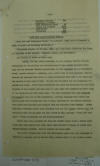
|
35.
December 16, 1931. G-2
Report on Latest Bandit
Activities, Major A. R. Harris,
Military Attaché, San José, p.
2.
"
. . . American Officers 202 ¶
Nicaraguan Officers (2nd
Lieutenants only) 37 ¶ Cadets
and Soldiers 2150 ¶ Auxiliaries
300 ¶ Volunteers 311 ¶ 3000 ¶
WHEN THEY ALMOST CAPTURED
MONCADA ¶ From the same
Nicaraguan Diario, “LA NOTICIA”,
under date of December 1, 1931,
we quote the following
headlines:-- ¶ “PRESIDENT
MONCADA WAS IN ROTA, LEÓN, AND A
FEW HOURS AFTERWARDS THE PLACE
WAS ATTACKED BY 200 BANDITS.
NUMEROUS COMBATS AND
ENCOUNTERS.” ¶ The article to
which we refer says: ¶ Sunday,
the day before yesterday, in the
morning, General Moncada,
accompanied by the Minister and
sub-Secretary of War, doctor
Antonio Flores Vega and don
Fernando Córdoba respectively,
by the Commander of the
President’s Guard, Captain
Herbert S. Keimling, and a small
body of foot soldiers, went to
inspect the railroad line which
is being constructed from León
to El Sauce and had arrived at
the town of Rota. In Rota the
President and his companions
remained some hours. Three hours
afterwards and while the
President and the Chief Director
of the Guardia has lain down to
rest, they were awakened by
three rings of the telephone and
left their beds. The call
announced that Juan Gregorio
Colindres at the head of 200
Sandinistas, strongly equipped
with rifles and machine guns had
attacked the Camp at Rota,
captured all the Guardia
Nacional that formed the
garrison and stripped them and
assaulted them cruelly. Advice
from Rota yesterday states that
Colindres took all the rifles,
machine guns and ammunition from
the garrison and went toward La
Paz, yelling – “Long Live
Sandino” – “Death to Moncada and
the North Americans.” ¶ While
they were pillaging the camp the
bandits spoke about a forced
march which they made toward
this camp, where they thought to
engage in combat with General
Moncada himself. General Moncada
had great luck. ¶ The above
notices taken from this
Nicaraguan paper have been
confirmed in detail by a message
sent by General Díaz, another
Chief of the Sandino forces. . .
. "
|
|
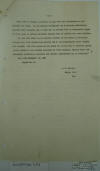
|
36.
December 16, 1931. G-2
Report on Latest Bandit
Activities, Major A. R. Harris,
Military Attaché, San José, p.
3.
"
. . . They have no reason,
therefore, to say that our
information is not exactly the
truth. If the dailies of Moncada
and of Moncada affiliation
publish these reports, why do
they try to pretend that an
independent paper of Costa Rica
is giving out false reports when
we publish the same articles. ¶
We note that there is no
absolute freedom of the Press in
Nicaragua, because they have
established martial law in the
Departments which Sandino has
invaded. For this reason we are
sorry not to be able to continue
giving entire credit to the
notices published by these
dailies, because where the
censorship prevails no complete
and certain information can be
obtained.” ¶ San José--December
16, 1931 ¶ Report No. 6, ¶ A. R.
Harris, ¶ Major, G.S. ¶ M.A."
|
|
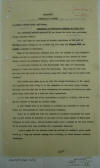
|
37.
December 14, 1931. G-2
Report on Activities of
Nicaraguan Refugees in Costa
Rica, Major A. R. Harris,
Military Attaché, San José, p.
1.
"NICARAGUA
¶ POPUALTION & SOCIAL ¶ No. 2700
– Public Order and Safety ¶
Activities of Nicaraguan
Refugees in Costa Rica. ¶ The
following article appeared in
the Diario de Costa Rica
yesterday, Sunday December
13th:-- ¶ “For some days we have
known of certain activities on
the part of the Nicaraguans
living in our country and that
they are aligned with the
Sandino movement in Nicaragua. ¶
Many of the Nicaraguan refugees
have left the country to join
Sandino’s forces and now on
account of the notices arriving
of the advance of these forces
toward the principal cities,
these activities here have
intensified. ¶ We have been
informed by some Nicaraguans
that they are organizing groups
to leave the country bound for
Nicaragua. They told us also
that San Juan del Sur would be
the meeting place from where
they would unite with Sandino.”
¶ This matter was taken up by me
with the Chargé d’Affaires of
the American Legation who will
bring it to the attention of the
Costa Rican Foreign Minister and
see what can be done concerning
the practice of Nicaraguan
refugees using Costa Rica as a
base for their operations. ¶ I
have also sent the above
information to Major R. Griffin,
G-2 of the Marine Brigade at
Managua by airmail today. ¶ I
will follow this up as closely
as possible and endeavor to
learn the names and destinations
of these Nicaraguan refugees. ¶
There is no doubt but that the
reports of Sandino’s successes
are causing a great amount of
activity on the part of the
large number of Nicaraguan
refugees in Costa Rica. Unless
Sandino meets with a reverse in
the near future it is believed
that this activity will
constantly increase. ¶ A press
agent for the Marines equal in
ability to Sandino’s press agent
would go a long way towards
curbing this activity, in these
Central American countries. . .
. "
|
|
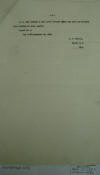
|
38.
December 14, 1931. G-2
Report on Activities of
Nicaraguan Refugees in Costa
Rica, Major A. R. Harris,
Military Attaché, San José, p.
2.
"
. . . As an Army officer I have
never thought until now that the
Marines were lacking in press
agents. ¶ Report No. 4 ¶ San
José--December 14, 1931 ¶ A. R.
Harris, ¶ Major, G.S. ¶ M.A."
|
|
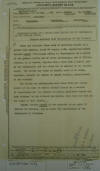
|
39. December 2,
1931. Naval Intelligence
Report on "Photostat Copies of a
Letter from Sandino and of
Photographs of His General
Staff," Military Attaché,
Tegucigalpa.
"There
are enclosed three sets of
photostat copies of a letter
from Sandino, dated 29 August,
1928, appointing Manuel Antonio
Lacayo (Nicaraguan living in
Tegucigalpa) as a member of his
general staff, and of three
photographs, one of William
Johnson, U. S. Marine, hanging
from a tree with a bandit jefe
in the background, and the other
two of members of his general
staff. The latter was taken in
bonilla park at La Ceiba,
Honduras, beneath the statue of
Manuel Bonilla, ex-president of
the country. ¶ The letter and
photographs were taken from the
inside pocket of the coat of
Manuel Antonio Lacayo in a
cantina in Tegucigalpa for the
purpose of making photostat
copies and then returned to him
without his knowing that they
had been in the hands of this
office. ¶ Manuel Antonio Lacayo
is now reported as an agent of
Sandino in Honduras, and is
under the observation of the
Government of Honduras."
|
|
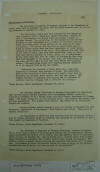
|
40.
November-December 1931.
Press Releases, US State
Department, on Revolutionary
Activities in Nicaragua (Press
releases of Nov 27, Nov 30 & Dec
2, 1931).
"NICARAGUA
– (Political) ¶ 3020 ¶
Revolutionary Activities. ¶ The
Secretary of Legation at Managua
reported to the Department of
State, under date of November
26, 1931, that President Moncada
made the following statement on
November 25, 1931: ¶ “The
Nicaraguan people have been
informed by the newspapers that
a group of about eighty men,
mainly Hondurans, entered the
city of Chichigalpa last Sunday
night and looted a number of
business houses. The authorities
of Chichigalpa and the Guardia
Nacional of that Department with
a number of civilians, General
Noroi and others, went to the
defense of the city and to fight
the bandits. The latter took the
city at eight thirty and retired
at eleven thirty when the first
detachment of loyal forces
appeared in the suburbs of the
city. This demonstrates that
they do not wish to fight, that
they seek defenseless towns to
loot, that they are not inspired
by ideas, party, nor of
patriotism. On the other hand
they told the people in
Chichigalpa that what they took
belonged to the people, that
they, the inhabitants of the
city, had the right to take what
they wanted from property
owners. The assaulting troops
were cheering General Colindres
so it is supposed that he was
the leader. ¶ “Colindres is a
brother of Pedro Irias for a
long time Secretary to Sandino,
both natives of Murra. The
assailants fled in the direction
of Villa Nueva with beasts taken
from the Haciendas Las Grietas,
Santa Emilia, San Juan and
others. The Guardia Nacional is
pursuing them closely and is
confident of subduing them and
obliging them to evacuate the
country.” ¶ (Press Release,
State Department, November 27,
1931.) ¶ The American Charge
d’Affaires at Managua
telegraphed the Department that
the Nicaraguan Guardia reported
that a Nicaraguan Guardia patrol
was attacked on November 27 by a
bandit group near Villa Nueva,
Department of Chinandega. The
fight lasted for one and
one-half hours. The bandits had
machine guns and were
aggressive. Five bandits were
killed. One member of the
Nicaraguan Guardia was wounded.
¶ Another Guardia patrol engaged
a group of bandits on November
27, near Puentereal, Department
of Chinandega. Five bandits were
killed. There were no Guardia
casualties. ¶ The Department of
State has been informed that the
Nicaraguan Government is taking
additional steps to reinforce
the strength of the Guardia to
meet this recent recrudescence
of banditry. ¶ (Press Release,
State Department, November 30,
1931.) ¶ The Secretary of
Legation at Managua, Nicaragua,
reported on December 1, 1931,
that a patrol of 10 Nicaraguan
Guardia and 53 auxiliaries
(Nicaraguan) encountered 80
bandits at El Caudro, near Las
Zapatas, about 25 kilometers
north of Leon, on November 29.
One auxiliary and 1 civilian
guide were wounded. Later
information indicated that
several bandits were killed and
wounded. The bandits
counter-attacked before retiring
and recovered the bodies of 3 of
their men. On November 30 about
180 bandits looted the town of
Rota, on the railroad between
Leon and El Sauce, and tore up
part of the railroad. ¶ (Press
Release, State Department,
December 2, 1931.)"
|
|
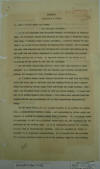
|
41.
December 1, 1931. G-2
Report on the Military
Situation, Major A. R. Harris,
Military Attaché, San José, p.
1.
"NICARAGUA
¶ POPULATION & SOCIAL ¶ No. 2700
– Public Order and Safety. ¶ The
Military Situation. ¶ 1. In our
interview with President Moncada
of Nicaragua on November 19th,
the President seemed very
desirous of organizing a
temporary volunteer army, -
probably under General
Escamilla, a Mexican soldier of
fortune, - as an aid to the
Guardia in fighting the bandits.
The President was very much
worried over the situation and
believed the Guardia to be too
small and too widely over the
situation and believed the
Guardia to be too small and too
widely dispersed to handle the
situation and prevent it from
getting out of hand. He appeared
sincere in his desire to do
everything in his power to put
down the banditry. ¶ 2. The
State Department, however, seems
very much opposed to this
project. In a conversation with
Mr. Beaulac, the American Chargé
d’Affaires, the reasons for this
attitude were given as follows:-
¶ a. A similar force, under
General Escamilla was sent into
the field about two years ago in
the hope that the bandits would
be more successfully combatted
by troops using their own rough
and ready methods. However, the
volunteer force failed to make
any great headway. A large
number of so called bandits were
killed, - but rumors were
current that the bandits killed
were practically all of the
Conservative (opposition) Party.
¶ b. The prime reason for the
present Guardia is to provide
the Nation with a non-political
military force, - not controlled
by either party and capable of
serving the Nation rather than a
faction. If a volunteer force is
organized, it will be a
political force loyal to, and
depending for its existence on
one faction only. If it is
successful against the bandits,
it will tend to discredit the
Guardia. Also the question of
“unity of command” is an
important consideration. It is
feared that the creation of a
strong volunteer force would be
the opening wedge for the
breaking . . . "
|
|
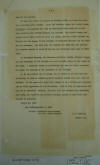
|
42.
December 1, 1931. G-2
Report on the Military
Situation, Major A. R. Harris,
Military Attaché, San José, p.
2.
"
. . . down of the Guardia. ¶ 3.
Upon our return to Managua on
November 27th, we found the
military situation much changed.
About 180 bandits, under the
bandit leader Colindres, had
captured the town of Chichigalpa
near León and on the main
railroad line between Managua
and Corinto. The actual damage
was slight (about $4000 worth of
booty was taken, and one police
officer was killed) but the
damage to the prestige of
President Moncada and the
Guardia was enormous. The fact
that the bandits all fled upon
the arrival of a Guardia patrol
of about 20 men did not
influence this loss of prestige.
¶ 4. President Moncada, the
Minister of Public Safety,
General Somoza, and the
Commander of the Guardia were
all at León, close to the scene
of the raid. A volunteer force
of practically 200 men was being
organized, but under the command
of the Commander of the Guardia.
¶ 5. My impressions may be
wrong, but it seemed to me that
the Conservatives to whom we
talked appeared somewhat elated
over this turn of affairs. In
the space of a week they seemed
to be a little more pronounced
in their opposition to the
President. This is only my
impression and may not be
accurate. However, the fact that
the bandits were operating near
León, the heart of the Liberal
country, seemed to give them
some measure of pleasure. ¶
Report No. 1472 ¶ San
José--December 1, 1931 ¶ Source
– Personal observations ¶ Lt.
Col. Cruse concurs. ¶ A. R.
Harris, ¶ Major, G.S."
|
|
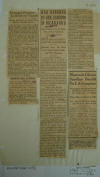
|
43.
December, 1931. News
clippings: Dec 1:
"Nicaragua Prepares to Reinforce
Guards,"
[New York?] Daily.
Dec 3: "Managua Adds To Guard,"
New York Times.
Dec 4: "War Renewed By Gen.
Sandino in Nicaragua,"
Baltimore Sun.
Dec 9: "Moncada Likens Sandino
Bandit to U.S. Gangster,"
Associated Press.
"Nicaragua
Prepares To Reinforce Guards ¶
Action Decided on After Two
Raids by Bandit Forces
¶ The Nicaraguan Government is
taking additional steps to
reinforce the strength of the
Guardia Nacional following two
bandit raids in Nicaragua Nov.
27, the Department of State
announced Nov. 30. ¶ The
Secretary of State, Henry L.
Stimson, questioned regarding
the bandit raids, stated orally
that the plan for training the
Guardia Nacional by American
marines was working well, and
that no changes in this plan
were contemplated. ¶ He stated
that banditry always has been
bad in the northern area of
Nicaragua and that he had no
specific explanation for the
present raids. ¶ The
Department’s announcement of
follows in full text: ¶ The
American Charge d’Affaires at
Managua, Willard L. Beaulac,
telegraphed the Department that
the Nicaraguan Guardia reported
that a Nicaraguan Guardia patrol
was attacked on Nov. 27 by a
bandit group near Villa Nueva,
Department of Chinandega. The
fight lasted one and one-half
hours. The bandits had machine
guns and were aggressive. Five
bandits were killed. One member
of the Nicaraguan Guardia was
wounded. ¶ Another Guardia
patrol engaged a group of
bandits on Nov. 27, near
Puentereal, Department of
Chinandega. Five bandits were
killed. There were no Guardia
casualties. ¶ The Department of
State has been informed that the
Nicaraguan Government is taking
additional steps to reinforce
the strength of the Guardia to
meet this recent recrudescence
of banditry. ¶ MANAGUA
ADDS TO GUARD. ¶ 300 More Men
Enlisted to Combat New
Nicaraguan Rebel Activity.
¶ Special to The New York Times.
¶ WASHINGTON, Dec.
2.—Strengthening of the
Nicaraguan National Guard as the
result of increased insurgent
activity in Northwestern
Nicaragua, was reported to the
State Department today by
Willard L. Beaulac, Secretary of
the American Legation at
Managua. ¶ The Nicaraguan
Government has added 300
short-term enlisted men to the
ranks of the guard. They are
designated as auxiliaries. ¶
WAR RENEWED BY GEN.
SANDINO IN NICARAGUA ¶ Nine
Clashes In As Many Days With
National Guard Reported ¶ STATE
DEPARTMENT IS MUCH CONCERNED ¶
Stimson Says He Does Not
Contemplate Sending More Marines
¶ By DREW PEARSON ¶
[Washington Bureau of The Sun] ¶
Washington, Dec. 5—A renewal of
civil warfare between General
Sandino’s followers and the
Nicaraguan National Guard, led
by Marine Corps officers, has
resulted in nine clashes in as
many days, according to reports
received by the State and Navy
Departments. ¶ Two members of
the National Guard have been
wounded and more than twenty of
the insurgent forces have been
killed. State Department
officials are concerned over the
renewal of fighting, but
Secretary Stimson stated he does
not contemplate sending more
Marines to Nicaragua. ¶
Rebels Called Bandits ¶
State Department officials have
endeavored to minimize the
significance of the
revolutionary outbreak and have
characterized the rebels as
bandits. President Moncada,
however, in a public
declaration, has said they were
led by General Colindres, a
recognized member of the Sandino
forces, and that the troops were
well armed and equipped. ¶
President Moncada claimed that
most of the rebels were
Hondurans. In the northern
section of Nicaragua, however,
the boundary between Honduras
never has been delineated and is
populated by natives who cross
and recross from one country to
the other with no recognized
nationality. ¶ Attacks
Along Main Line ¶
Explaining the clashes in
Nicaragua, Secretary Stimson
pointed out that there had
always been raids on villages in
the northern section. The
attacks during the past week,
however, have taken place along
the main line railroad in a
neighborhood hitherto unmenaced
during the American occupation.
¶ A total of about 900 marines
are now stationed in Nicaragua,
Marine Corps headquarters said
today. Of these, 675, excluding
officers, are for the purpose of
conducting an officers’ training
school, a legation guard, or are
attached to the aviation unit.
In addition to this total, 132,
excluding officers, are attached
to the National Guard. No
American marines, unless
attached to the National Guard,
are in any of the areas where
they come in contact with the
insurgents, Secretary Stimson
said. ¶ Reports On
Clashes ¶ The clashes,
according to reports received by
the State and Navy Departments,
follow: ¶ Nov. 22—Eighty men
captured in the city of
Chichigalpa, took the railroad
station and burned railroad
records. ¶ November 27—National
Guard patrol attacked near Villa
Nueva. Five insurgents killed,
one member of National Guard
wounded. ¶ November 27—National
Guard patrol attacked near
Puentereal. Five insurgents
killed. ¶ November 28—National
Guard patrol, commanded by
Sergt. Richard A. Thompson, of
Bloomingdale, Ind., clashed with
insurgents near La Pozas. Five
insurgents killed. ¶ November
28—National Guard patrol clashed
with insurgents near Olomega.
One insurgent killed. ¶
Rebels Lose Unknown Number
¶ November 29—National Guard
patrol of ten, with fifty-three
auxiliaries, clashed with eighty
insurgents at El Caudro. One
auxiliary and one civilian guide
wounded. The insurgents lost an
unknown number of men. ¶
November 30—Insurgents attacked
and looted town of Rota on
railway between Leon and El
Sauce, tearing up part of the
tracks. ¶ December 2—National
Guard patrol, under Gunnery
Sergeant Donald MacDonald, of
Backwood, Ark., encountered
insurgents near El Mojado. Five
insurgents killed. ¶
Moncada Likens Sandino Bandit To
U.S. Gangster ¶ Nicaraguan
President Points Out Outlaws Do
Not Occupy Single City or
Village ¶ Porto Rico to Discuss
Idle ¶ Gov. Roosevelt Calls
Labor and Business Men to Aid
¶ By The Associated Press ¶
MANAGUA, Nicaragua, Dec.
10.—President Jose M. Moncada,
returning from Leon with his
staff, said today that the
American press was misinformed
concerning the activities of
Augusto Sandino, outlaw
chieftain. “Sandinism does not
occupy one city or village,” he
said. The Nicaraguan government
controls the country, which is
in peace, and the bandit groups
can be compared to those seen at
any time in New York or Chicago.
Notwithstanding the economic
crisis encircling the world,
Nicaragua is within her budget,
which includes a National Guard
item of $1,000,000.” ¶ President
Moncada was reported to have
gone to Leon to protect the city
against Sandino and to launch a
new offensive against his
movements."
|
|
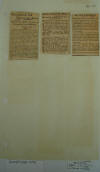
|
44.
November-December 1931.
News clippings: Nov 23:
"Nicaraguans Ask Hoover For
Army,"
Boston Transcript.
Nov 26: "Curbs Nicaraguan
Rebels,"
New York Times.
Dec 4: "Kill Ten In Nicaragua,"
New York Times. "Nicaraguans
Ask Hoover for Army ¶ Appeal for
Native Troops as Insurgents Loot
Railroad Town ¶
Managua, Nicaragua, Nov. 23
(A.P.)—Insurgents captured the
town of Chichigalpa on the
railroad between Chinandega and
Leon, yesterday, looting the
stores[,] wrecking the telegraph
office and burning the railroad
records, National Guard
headquarters reported today.
They were in the town about an
hour before the National Guard
patrol of thirty men arrived
from Chinandega, and drove them
toward the south. One guardsman
was killed. ¶ This was the first
time the insurgents have
approached the large cities
along the railroad. The
newspaper La Noticia published a
joint message cabled to
President Hoover by the Chambers
of Commerce of Leon, Managua,
and Chinandega, asserting that
there is insufficient protection
against insurgent attacks and
suggesting a national army be
organized under the direction of
President Moncada. ¶
CURBS NICARAGUAN REBELS. ¶
Managua Declares State of Siege
in Two Departments. ¶
By Tropical Radio to THE NEW
YORK TIMES. ¶ MANAGUA,
Nicaragua, Nov. 25.—A state of
siege was declared today in the
Departments of Leon and
Chinandega on account of the
activity of numerous well armed
insurgents under Juan Gregorio
Colindres, a Honduran. ¶ On
Sunday this band sacked
Chichigalpa, a railroad town
fifteen miles from Corinto,
principal port of Nicaragua. ¶
MANAGUA, Nicaragua, Nov. 25
(AP).—Brig. Gen. R. C. Berkeley
arrived today to take command of
the United States Marine forces
in Nicaragua, replacing Brig.
Gen. Frederic L. Bradman, who
will sail for San Diego on
Friday. ¶ President J. M.
Moncada and Brig. Gen. Calvin R.
Matthews, commander of the
Nicaraguan National Guard, went
to Leon today to investigate
insurgent activities in that
province and the Province of
Chinandega. ¶ KILL TEN
IN NICARAGUA ¶ Guardsmen Combat
Increasing Activity of
Insurgents in Leon Area.
¶ By Tropical Radio to THE NEW
YORK TIMES. ¶ MANAGUA,
Nicaragua, Nov. 30.—The railroad
tracks at Rota, fifteen miles
from Leon and on the route to El
Sauce, were torn up by
insurgents today, and rebel
acitivity [activity] in that
area is increasing. ¶ Ten
insurgents have been killed in
numerous recent engagements with
patrols of the Nicaraguan
National Guard in the vicinity
of El Sauce and Puerto Real.
Three guardsmen have been
wounded recently, none of them
Americans. ¶ The rebels are well
equipped and aggressive.
Officials at Leon and the
commander of the National Guard
are directing the operations
against them, while volunteer
groups have been formed to aid
the guardsmen."
|
|
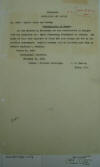
|
45. November 21,
1931. G-2 Report on
Concentration of Troops, Major
A. R. Harris, Military Attaché,
Tegucigalpa.
"All the Marines in Nicaragua
are now concentrated in Managua
with the exception of a small
forwarding element at Corinto.
The force at this date consists
of about 500 line troops and 200
in the aviation department.
General Bradman will be relieved
next week by General Randolph C.
Berkley. . . ."
|
|
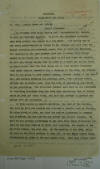
|
46.
November 21, 1931. G-2
Report on Bandit Situation,
Lieut. Col. Fred T. Cruse,
Military Attaché, Tegucigalpa,
p. 1.
"NICARAGUA
¶ POPULATION AND SOCIAL ¶ No.
2700 – Public Order and Safety.
¶ Bandit Situation. ¶ On
November 19th Major Harris and I
accompanied Mr. Beaulac to call
on President Moncada. We found
the President evidently very
much worried and almost in a bad
humor. With hardly any of the
usual preliminaries he turned to
Mr. Beaulac and said that the
bandit situation was extremely
grave; that at least 200
Hondurans had appeared in the
area between León and El Sauce;
that things seemed to be rather
out of hand; that he did not
blame the Guardia, as this was
strong enough only to serve as a
guard and police force at fixed
posts; that the only thing was
to send another volunteer Army
under General Escamilla for a
clean-up of the area, and
finally that he was going to
send General Somoza, Colonel
Watson of the Guardia, and
Captain Keimling his personal
Aide, with a Marine Patrol
through the disturbed area, with
the idea of explaining
conditions to the population.
The President further said that
he was constantly receiving
telegrams from the León area
expressing fear of bandit raids
on León and other towns, and
that the country in general was
uneasy over the situation. ¶ We
then called on General Matthews,
the head of the Guardia, who
told us that the bandits had
attacked a Guardia post at
Jicaral, 30 miles North of León,
and that the native Lieutenant
in command had withdrawn and the
bandits had burned the Guardia
station. He said he had patrols
converging on the area from
three directions and that he was
also sending in their last
reserves, the cadets of the
military school, the next day.
On the morning of the 20th,
while we were on the field
waiting to take off, we saw
these cadets being transported
by plane to the new bandit area.
They were rather badly . . . "
|
|
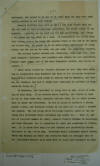
|
47.
November 21, 1931. G-2
Report on Bandit Situation,
Lieut. Col. Fred T. Cruse,
Military Attaché, Tegucigalpa,
p. 2.
"
. . . uniformed, but seemed to
be men of an alert type and they
were certainly anxious to get
into action. ¶ General Matthews
also told us that a few days
before they had the bad luck to
just miss killing Altamirano,
the chief leader of the bandits.
A guardia on the road saw two
men approaching, one riding a
big horse and the other on a
mule. As information has always
been that Pedron rode a big
horse the guardia fired at the
man on the horse and killed him.
He proved to be an unimportant
subordinate of Altamirano and
the man on the mule, who got
away, was Altamirano himself. ¶
The present bandit leaders are
Altamirano, José León Diaz,
Colonel Gregorio Colindres, and
possibly some others not yet
identified. Miguel Angel Ortez,
one of the most dangerous
leaders, was killed in August. ¶
After these visits Mr. Beaulac
informed us that they were
getting no cooperation from
Honduras and that on two
occasions President Moncada had
actually been ready to declare
war on Honduras, and that he,
Mr. Beaulac, had had to argue
most seriously to prevent him
from actually doing so. ¶ In
Honduras, the President is doing
what he can, which is nothing of
real help. If he arrests known
bandits, the Courts to whom he
has to turn them over, promptly
release them, for no other
reason than to annoy the
President. He has no money to
maintain a strong border patrol,
and Honduran forces do not know
how to guard a frontier anyway.
The one thing which President
Moncada asked is the one thing
that President Mejia Colindres
can hardly do - - that is, get
rid of Leopoldo Gamero in Danli,
General Teofilo Cárcamo in
Jacaleapa, and José Idiaquez,
who is sometimes in Danli and
sometimes in Cifuentes. It is
known that supplies for Sandino
are practically always delivered
to the latter man. President
Mejia Colindres cannot bother
these men because in their own
districts they are stronger than
he is. President Moncada also
said that he would like Honduras
to keep . . . "
|
|
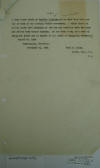
|
48.
November 21, 1931. G-2
Report on Bandit Situation,
Lieut. Col. Fred T. Cruse,
Military Attaché, Tegucigalpa,
p. 3.
"
. . . a very close watch on
Toribio Tijerino as he knew that
this man was in back of the
leading bandit movements. I
think there is little doubt that
Tijerino is the man who actually
gets the arms and starts them
toward Sandino. He has been
doing this sort of thing for
years and is expert in all sorts
of smuggling ventures. ¶ Report
No. 1470 ¶ Tegucigalpa,
Honduras. ¶ November 21, 1931 ¶
Fred T. Cruse, ¶ Lieut. Col.,
F.A. ¶ M.A."
|
|
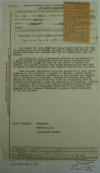
|
49.
November 4, 1931. Naval
Intelligence Report on
Activities of Bandit Agents in
Honduras, from "G", Tegucigalpa,
with newspaper clipping, Nov 22,
"Nicaraguans Rout Rebels,"
Associated Press. "NICARAGUANS
ROUT REBELS ¶ Guardsman Killed
Driving Raiders From
Chichigalpa—Plea to Hoover.
¶ MANAGUA, Nicaragua, Nov. 23
(AP).—Insurgents captured the
town of Chichigalpa, on the
railroad between Chinandega and
Leon, yesterday, looting the
stores, wrecking the telegraph
office and burning the railroad
records, National Guard
headquarters reported today. ¶
They were in the town about an
hour before a National Guard
patrol of thirty men arrived
from Chinandega and drove them
toward the south. In the
skirmish one guardsman was
killed. ¶ This was the first
time the insurgents had
approached the large towns along
the railroad. ¶ The newspaper La
Noticia published a joint
message cabled to President
Hoover by the Chambers of
Commerce of Leon, Managua and
Chinandega, asserting that there
was insufficient protection
against insurgent attacks and
suggesting that a national army
be organized under the direction
of President Moncada. ¶ On
October 27, 1931, José Leon
Diaz, bandit General, was seen
in Tegucigalpa, and an attempt
was made to obtain his arrest.
The police cooperated and
cornered Diaz but he finally
made good his escape. ¶ On
October 28, 1931, information
relative to the location of a
small quantity of contraband
rifle and pistol ammunition was
obtained and an attempt was made
by the police to capture it.
However, the parties holding
same became suspicious and were
able to remove it from
Tegucigalpa with apparent
destination Nicaragua. ¶ Much
reliable information is in the
possession of this office
relative to the activities of
agents of Sandino. Without doubt
these agents are obtaining
ammunition in this country and
forwarding it to Sandino in
Nicaragua. Government officials
have been advised of this
practice with the object of
interesting them in stopping the
smuggling of arms and ammunition
to Nicaragua. However, it is
apparent that due to the
boundary dispute between
Honduras and Nicaragua and the
economical condition of the
country, the attitude of the
Honduran Government is against
aiding Nicaragua in its
difficulties. COPY FURNISHED:
Comsperon, ¶ HQTRS U.S.M.C. ¶
Sec. Brigade Managua"
|
|
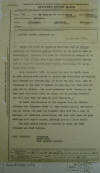
|
50.
October 28, 1931. Naval
Intelligence Report on Movements
of Sandino Agents, from "G",
Tegucigalpa, Honduras.
"During
the month of August of this year
José de Paredes (Mexican) and
Socrates Sandino (brother of the
bandit) came to Tegucigalpa.
Socrates left here for Choluteca
in company of an agent of this
office, from which place he
disappeared; Paredes left no
trace of himself after leaving
Tegucigalpa for an unknown
destination. ¶ On 1 September,
1931, an agent was sent to
Danlí, where he made contact
with agents of Sandino and
definitely established that
Paredes and Socrates had, of
their own free will, gone to
Nicaragua to the camp of Sandino
to join him, and that they had
gone via El Paraiso. The agent
proceeded to El Paraiso in the
hope that they might still be
there, but on arrival verified
the fact that they had gone on
into Nicaragua. ¶ In Danli
investigation of the reports
that Dr. Alfredo Zambrano and
Alejandro Cerda G., were bandit
agents, one accusing the other,
was made and reported that this
was a case of personal and
political animosities, but that
both have had some dealings with
bandit agents, although not on a
large scale. ¶ The more active
agents of Sandino in Danli are
José Idiaquez and José Guillen.
¶ COPY FURNISHED Comsperon ¶
Hqtrs USMC ¶ Sec. Brigade
Managua"
|
United States National Archives, Record Group
165, Entry 77, Box 2653.
|

